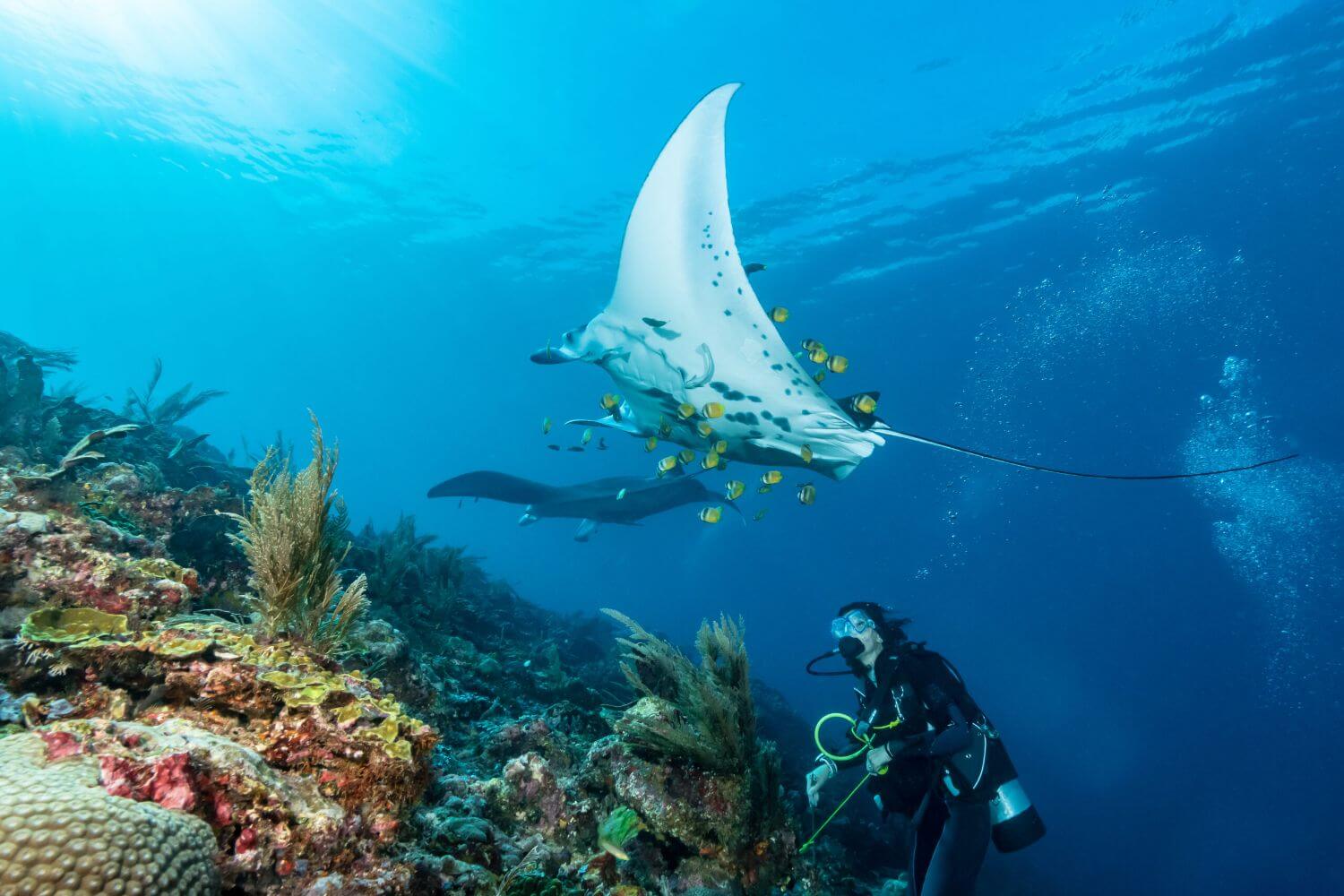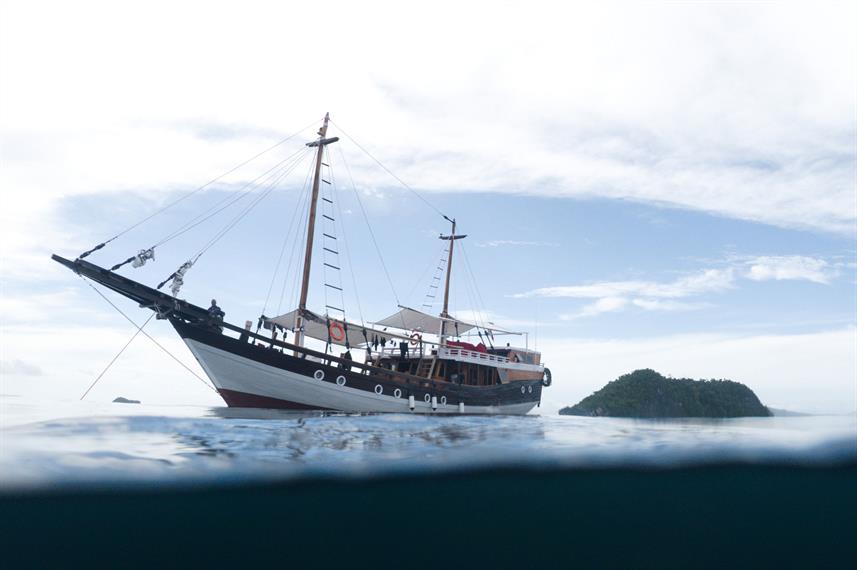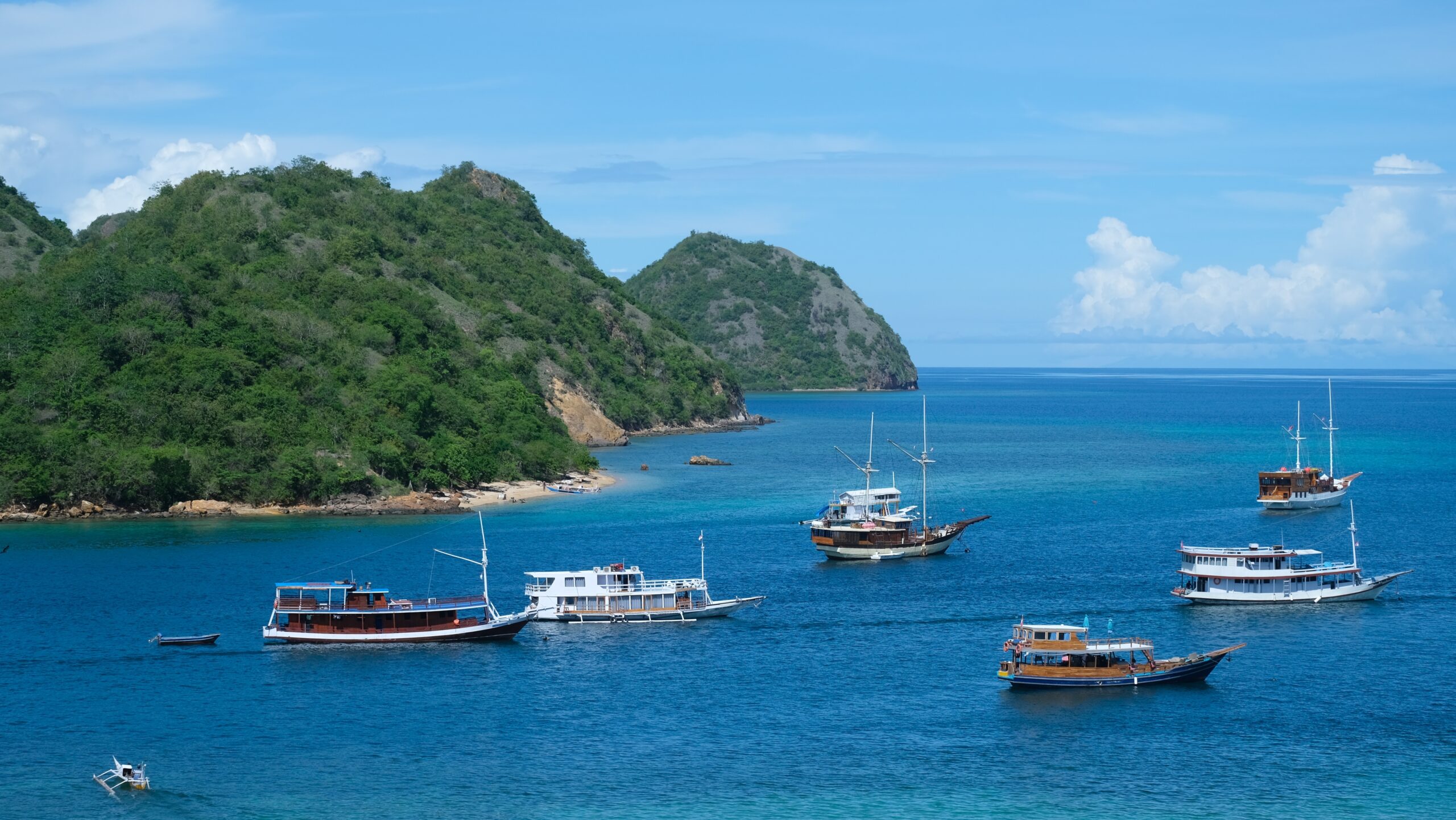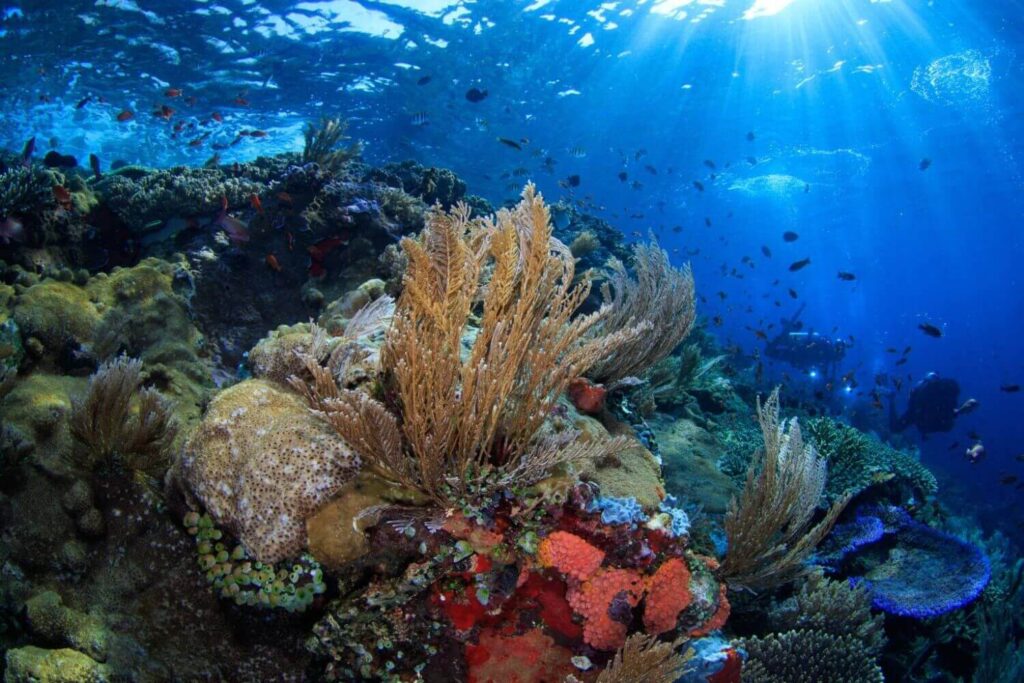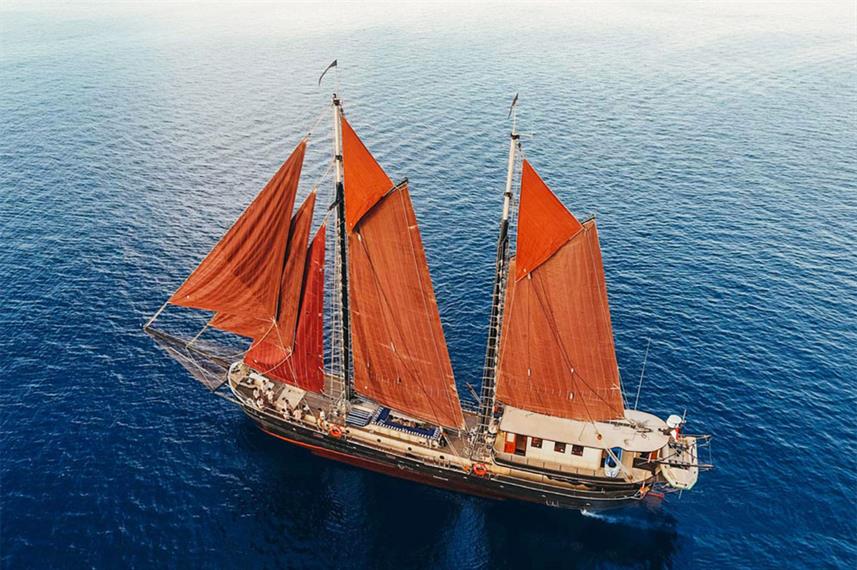
Located in Indonesia close to Bali, Komodo National Park is one of the world’s best places to scuba dive; with superb coral reefs, epic underwater landscapes and many manta rays and sharks.
Scuba diving Komodo is best done with a liveaboard which can take you to the best Komodo dive sites; those that are too remote to normally be reached.
In 2023 I went on a Komodo liveaboard and had the best week of diving in my entire life! In this guide; I’ll tell you all about my experience as well as what to expect when going on a Komodo liveaboard, packing list suggestions and more.
There are many different Komodo liveaboards to choose from and they vary a lot in terms of cost, itinerary and extra activities.
On the cheap end of the price-spectrum you get smallish vessels with basic cabins that operate 4 – 7 night long trips. These are especially popular with backpackers!
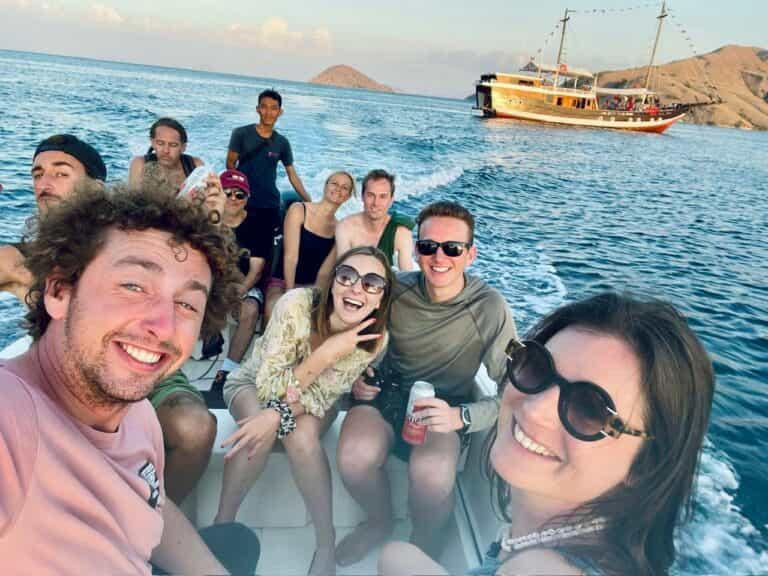
Then there are luxury Komodo liveaboards – huge vessels with things like private balcony cabins, spas and extra activities such as watersports and yoga.
These liveaboards often offer longer dive trips that can last for up to 2 weeks, although shorter trips are still also available.
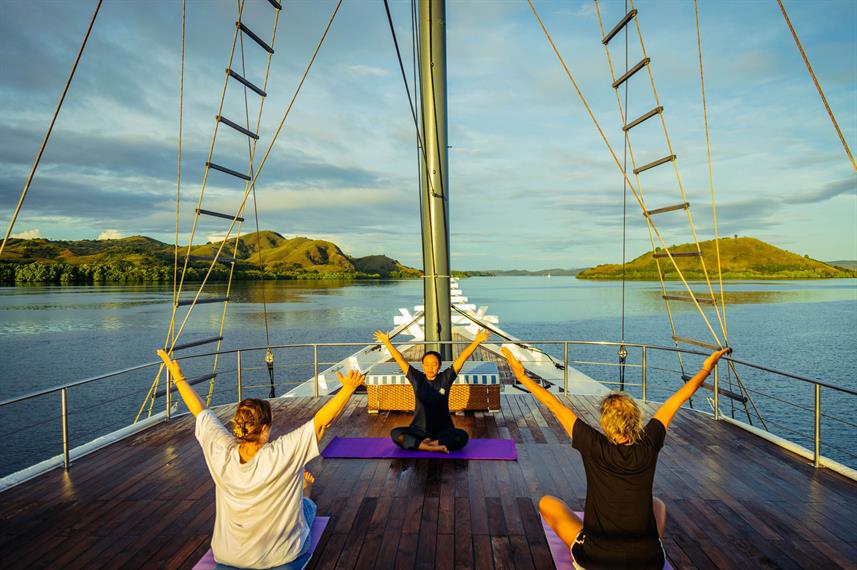
In this epic guide of awesomeness, we’ve summed up the Best Komodo Liveaboards of 2025; from the cheap and affordable to the mega luxurious.
Key factors like cost, itinerary and extra activities have all been factored in as we present Komodo liveaboards journeyed on by myself and other Diving Squad members. Let’s dive in and take a closer look!
1) TOP PICK: Akomo Isseki
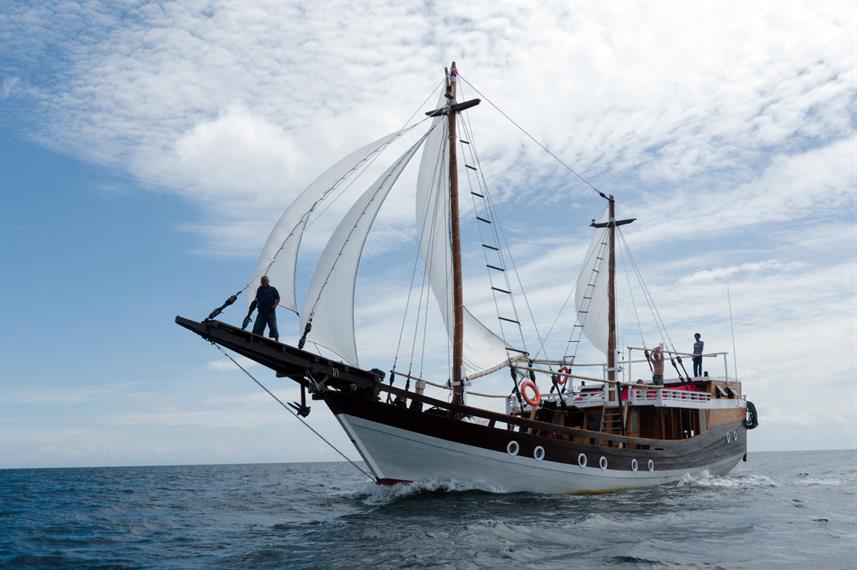
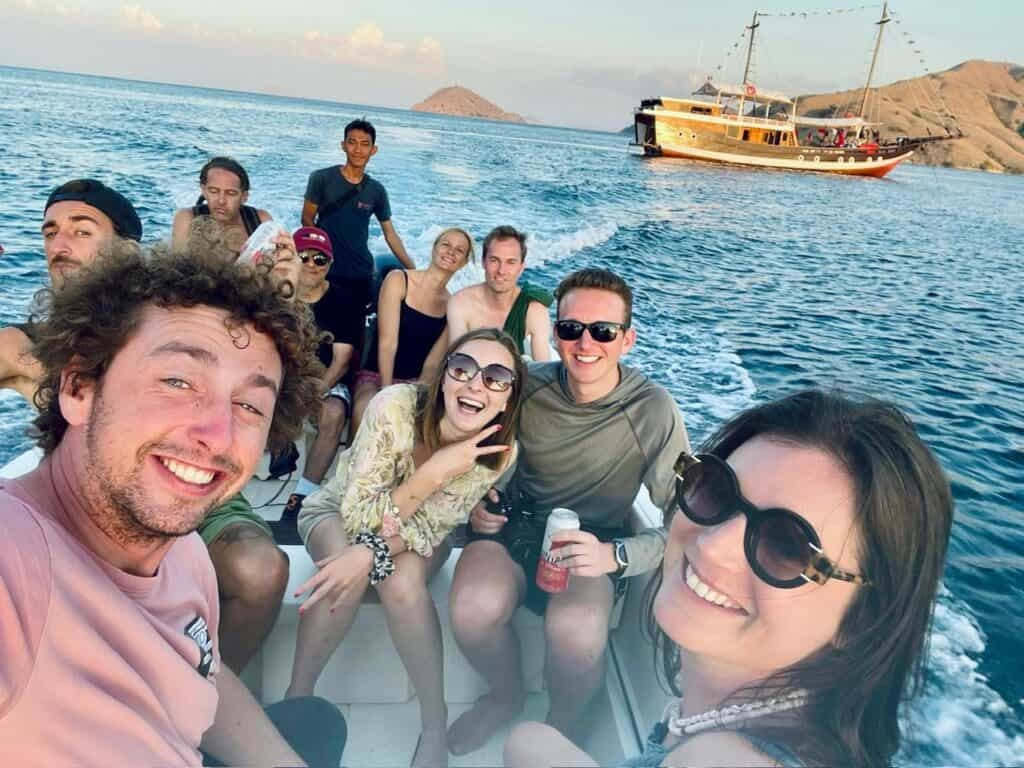
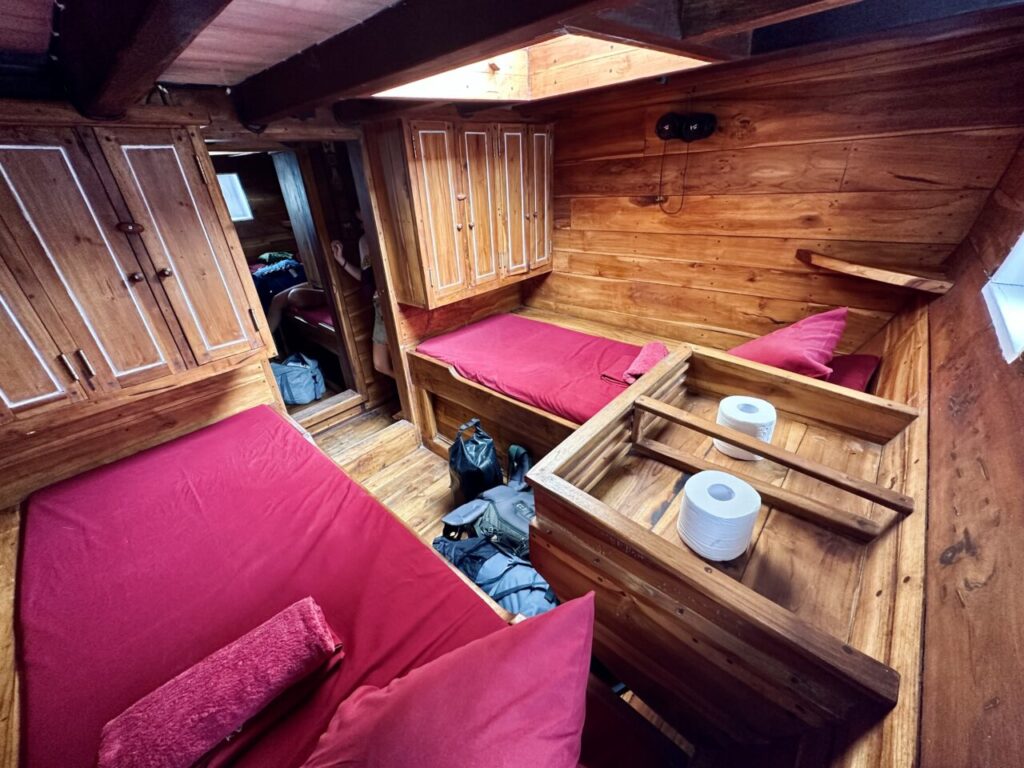
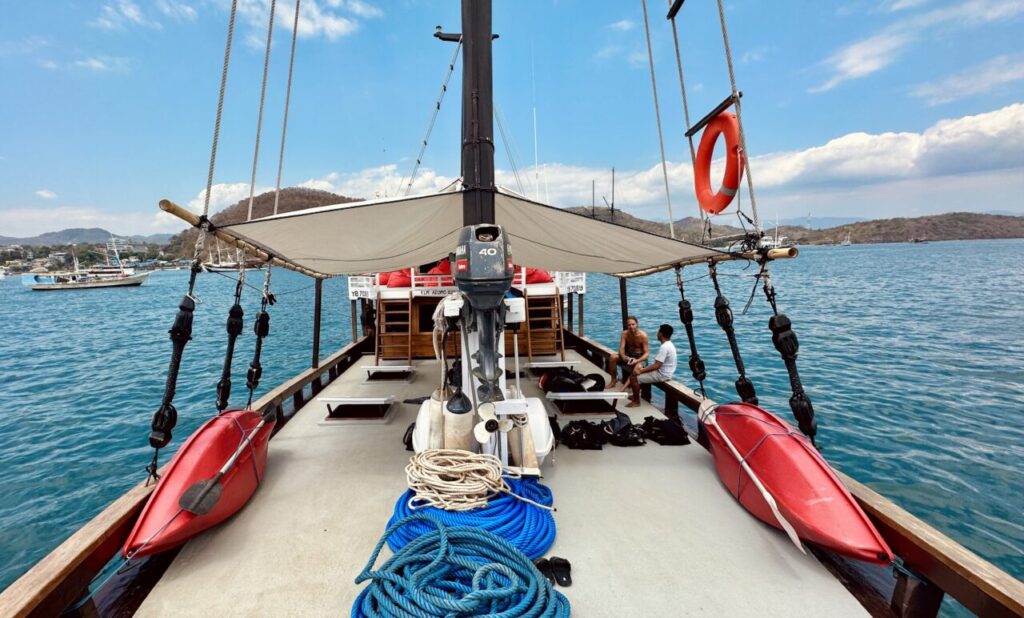
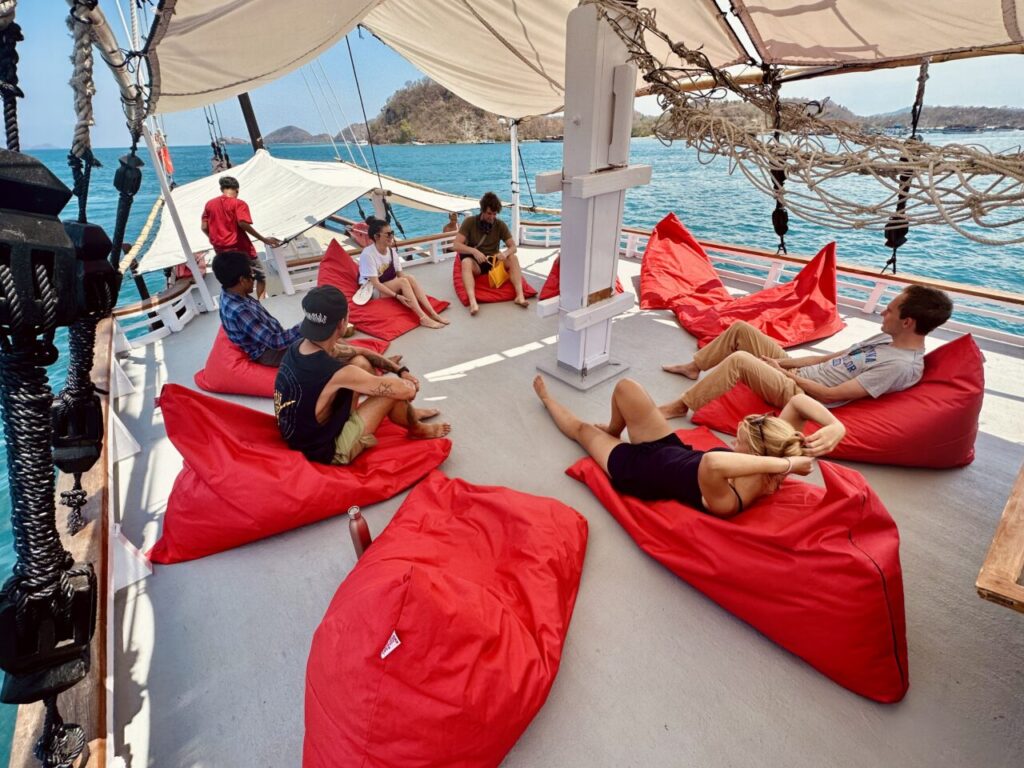
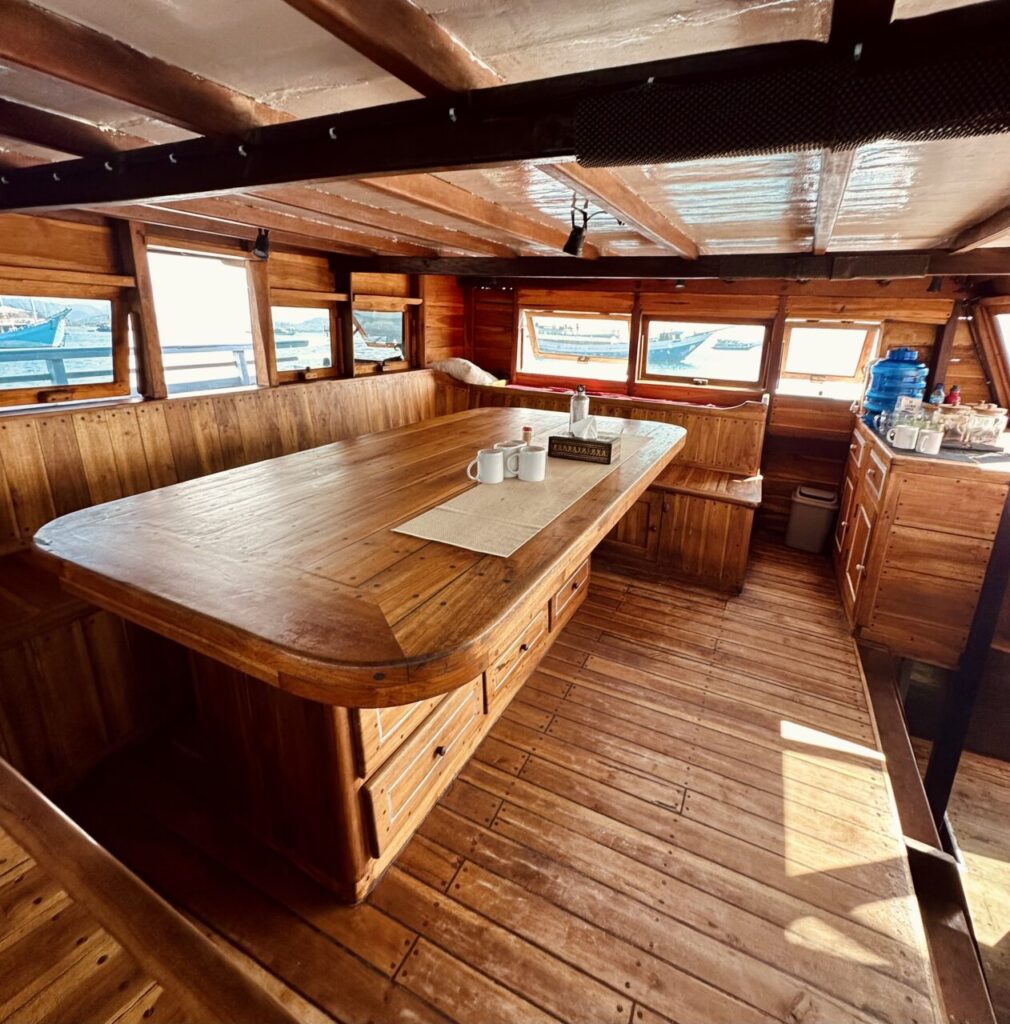
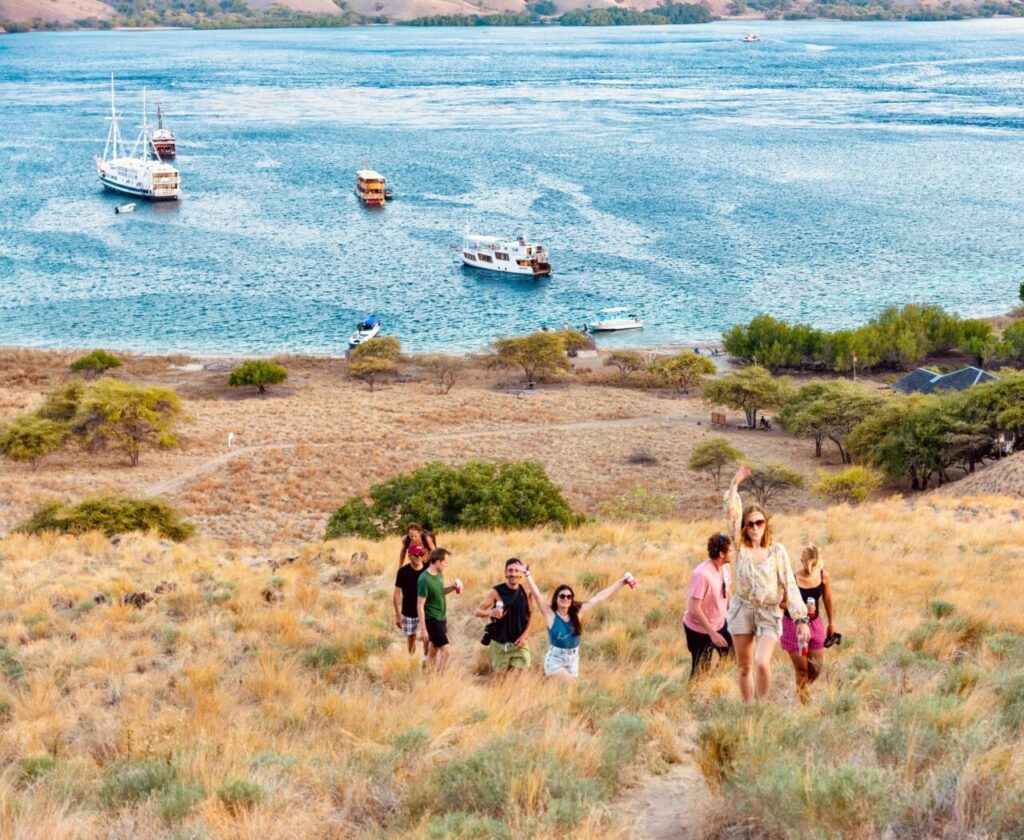
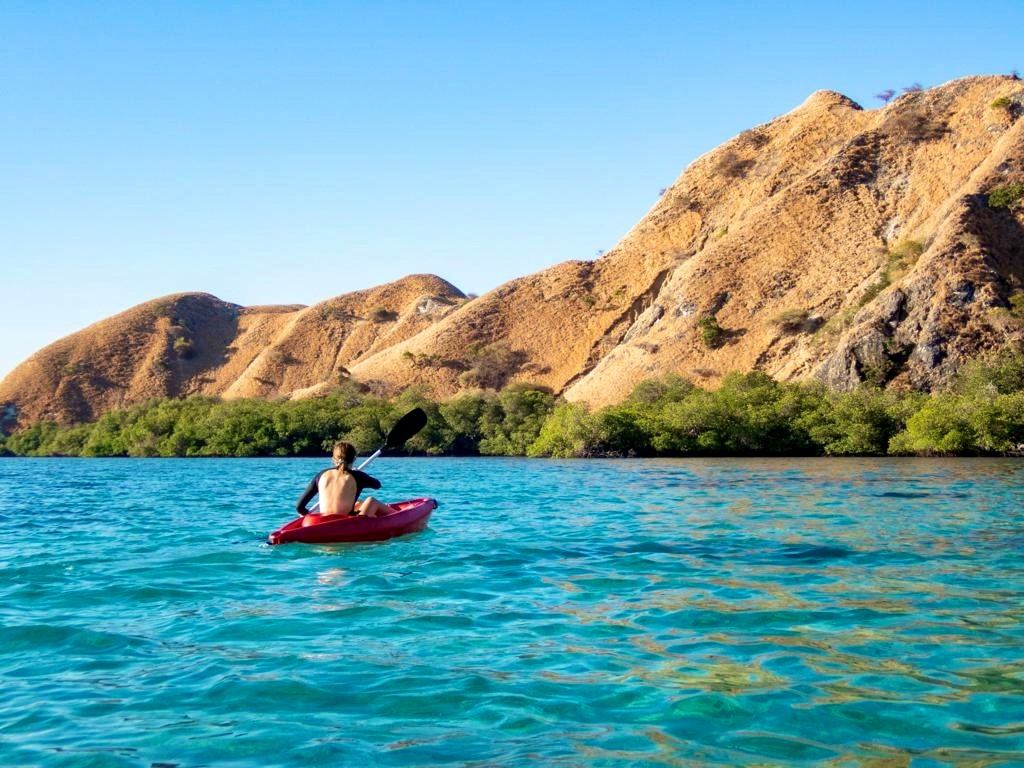
- Price: > $$
- 7 Night Trips. Discover Komodo’s best dive sites.
- Awesome Value for Money
- Social Atmosphere (a “liveaboard for backpackers”)
- Kayaking, Viewpoint Treks & Komodo Dragons
Akomo Isseki was one of the coolest liveaboards I’ve ever been on – not just because of the incredible scuba diving around the Central & North Komodo dive sites – but also the immensely fun and social atmosphere onboard.
I really loved the extra activities which included viewpoint treks, kayaking, beach bbqs and even a trip to Rinca Island on the last day to see the legendary Komodo dragons themselves.
At 27 meters long, Akomo Isseki is a medium-sized wooden Phinisi, it is more affordable than most other Komodo liveaboards as it is aimed towards backpacker-diver types.
There are four twin bed cabins with natural venting and shared bathroom facilities. The most popular social area is the partially covered sun deck complete with hammock and beanbags- a perfect place to take in the views with an icy beer at the end of each day.
QUICK LOOK – Best Komodo Liveaboards:
| Check on LiveAboard | Name | Price | Max Guests | Trip Length (Nights) | |
|---|---|---|---|---|---|
Check Here | Akomo Isseki | 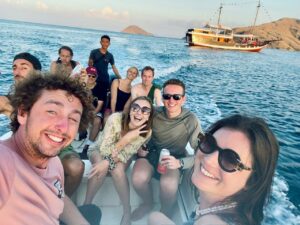 | $$ | 14 | 5 – 11 |
Check Here | Adeelar | 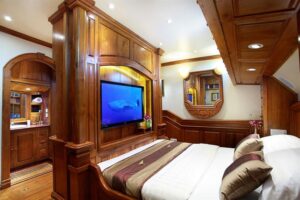 | $$$ | 8 | 10 |
| Check Here | Gaia Love | 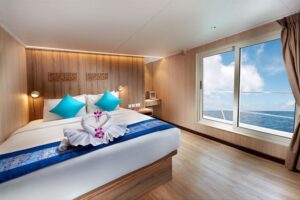 | $$$ | 22 | 9 – 11 |
| Check Here | Scubaspa Zen | 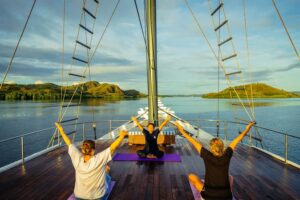 | $$$ | 18 | 7 – 10 |
| Check Here | Busy Girl | 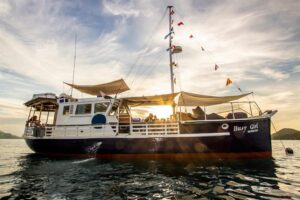 | $ | 4 | 2 – 4 |
| Check Here | La Galigo | 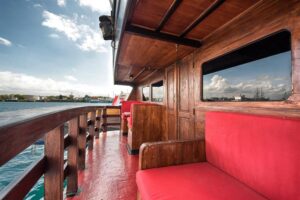 | $$ | 14 | 5 – 7 |
| Check Here | Carpe Diem | 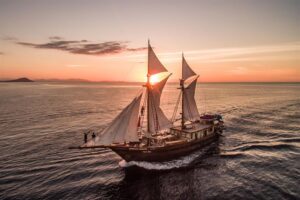 | $$ | 8 | 5 – 7 |
| Check Here | Queenesia | 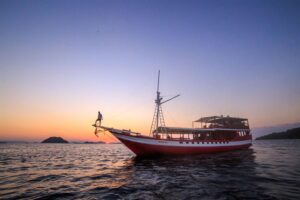 | $ | 8 | 5 |
| Check Here | Nusantara | 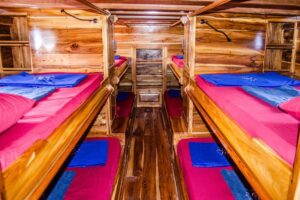 | $ | 12 | 2 – 3 |
| Check Here | Ecopro Dayung Baru | 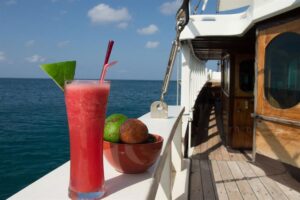 | $$ | 6 | 3 – 7 |
2) Most Luxurious Komodo Liveaboard: Adeelar

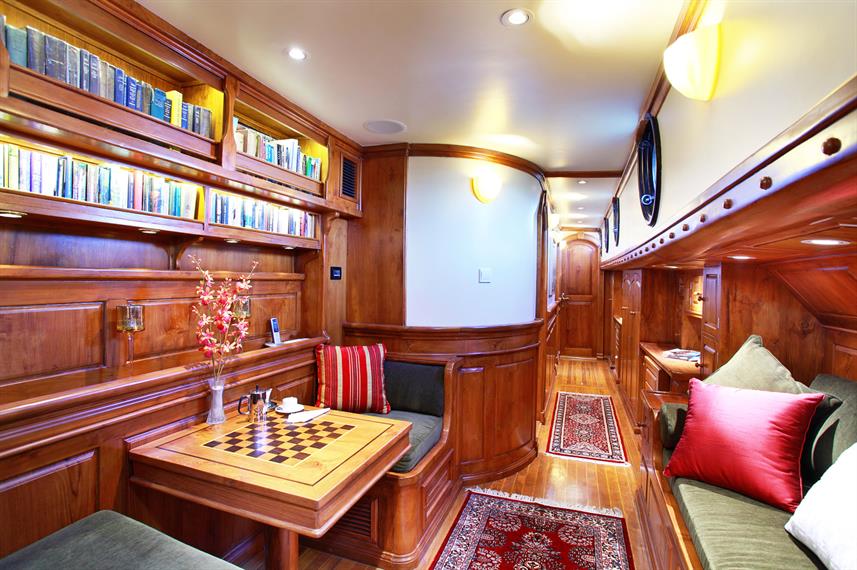
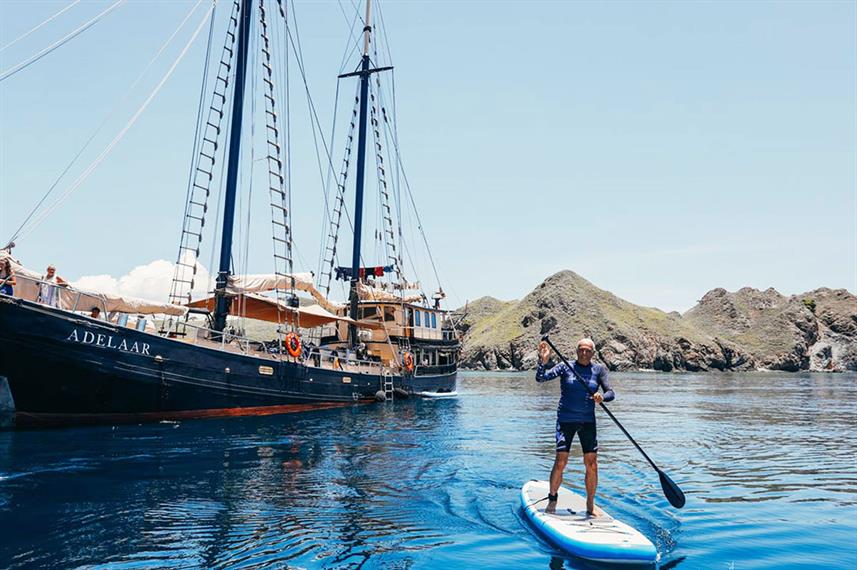
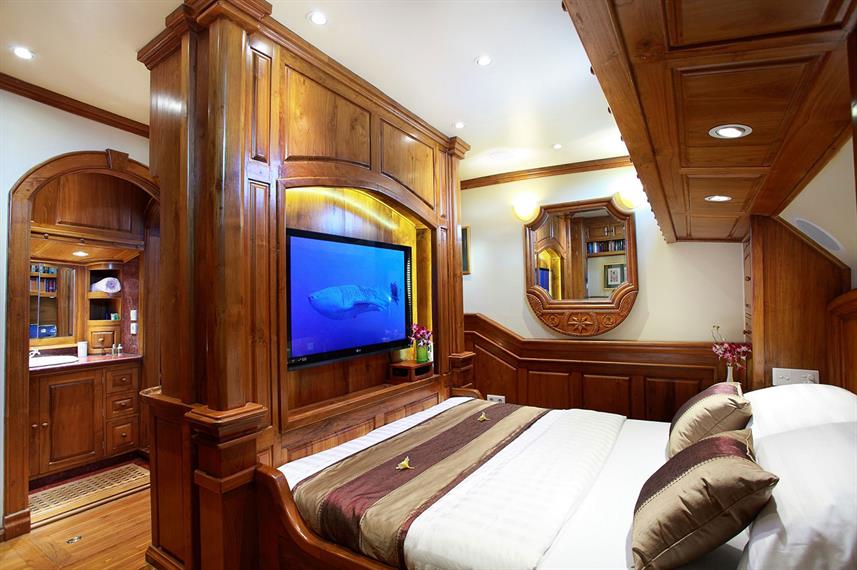
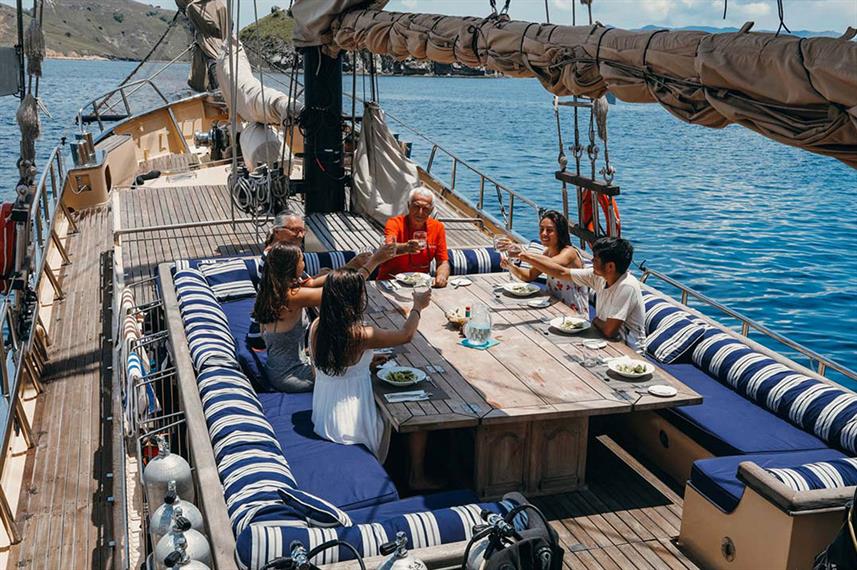
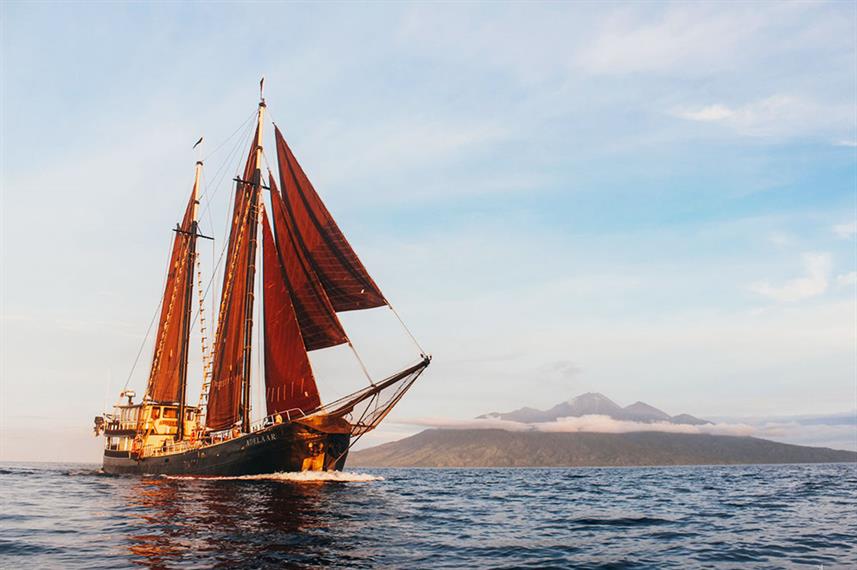
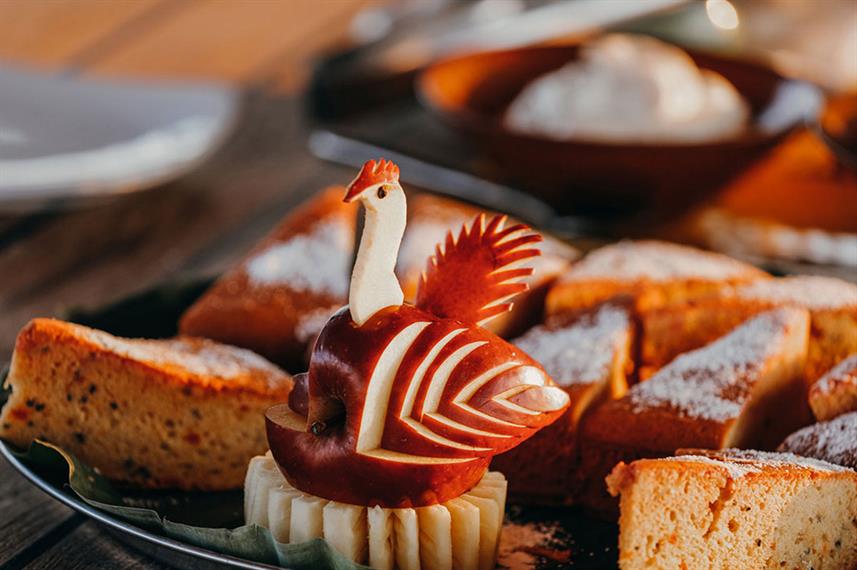
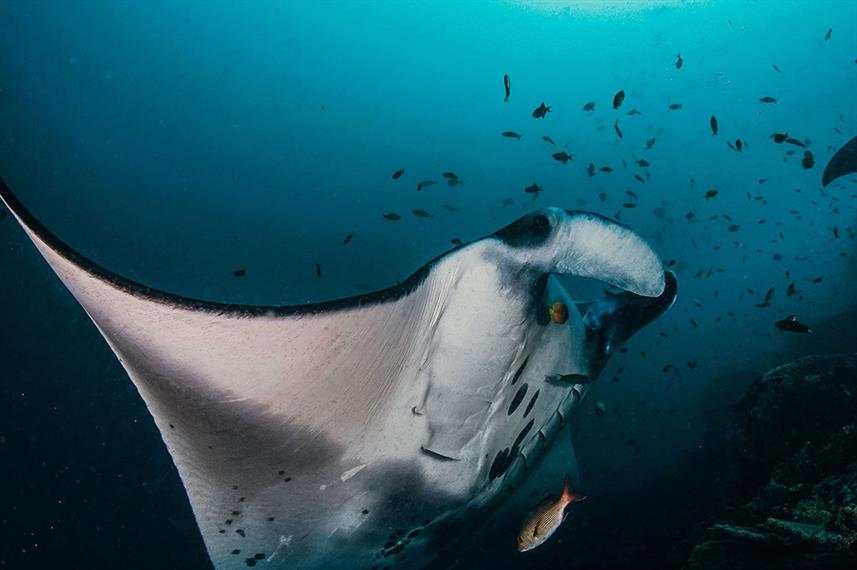
- Price: > $$$
- 6 – 10 Night Trips
- Lavish Cabins
- Incredible Food & Outstanding Customer Service
- Komodo Dragon visit
Adelaar is a state-of-the-art, 39 meter long Dutch Schooner designed with the luxury diver in mind. It is beautifully crafted with teak paneling, high ceilings and lavish common areas and cabins.
All cabins feature marble bathrooms and flatscreen TV’s; in truth they look more like luxury hotel rooms than a cabin on a boat.
The ten member crew are highly experienced and professional; they will attend to guests every need. Cuisine is a mixture of extremely high quality Indonesian and Western food.
Adeelar offers a variety of scuba diving safaris around Komodo that range from 6 to 10 nights; the longer routes also often include extra dive sites from Indonesian destinations close to Komodo such as around Bali.
3) Longest Trips: Gaia Love
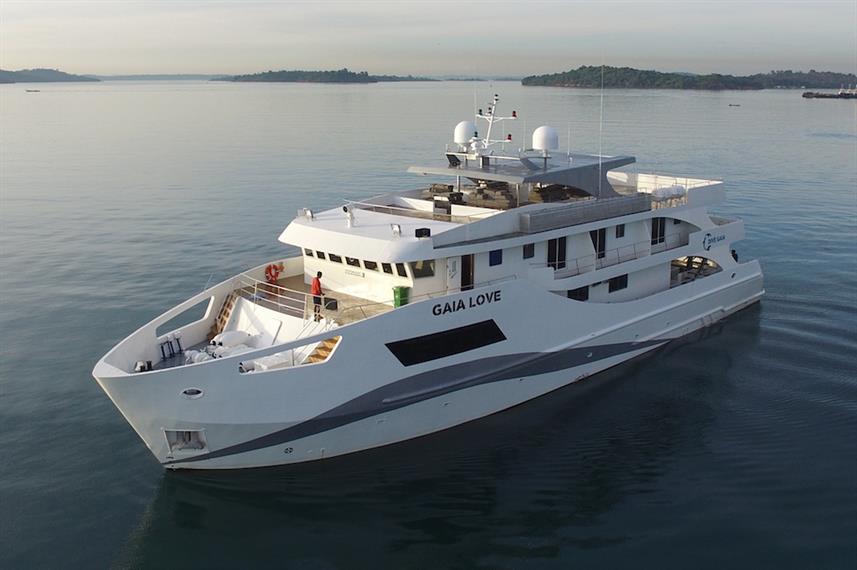
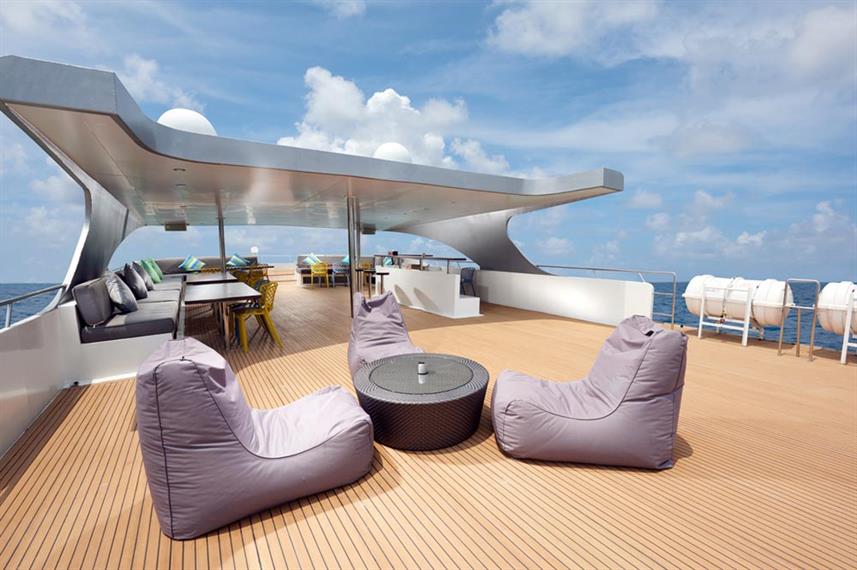
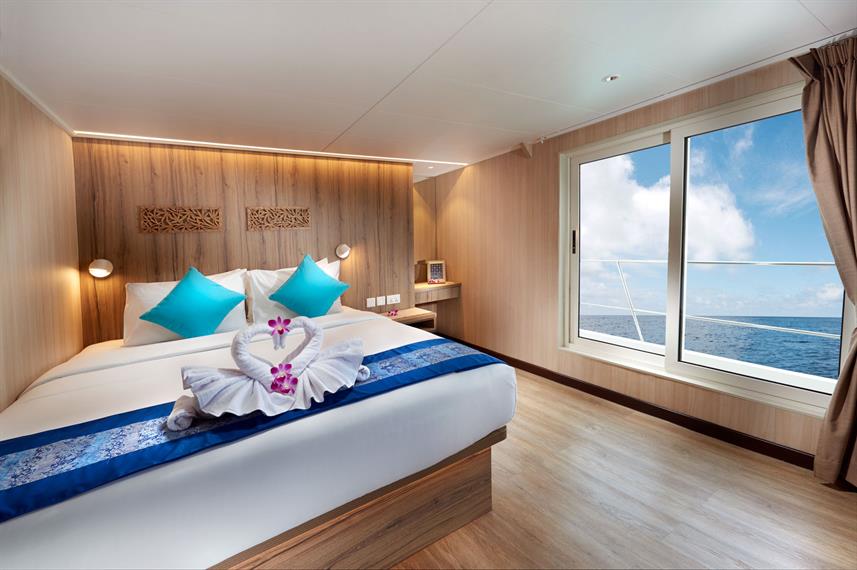
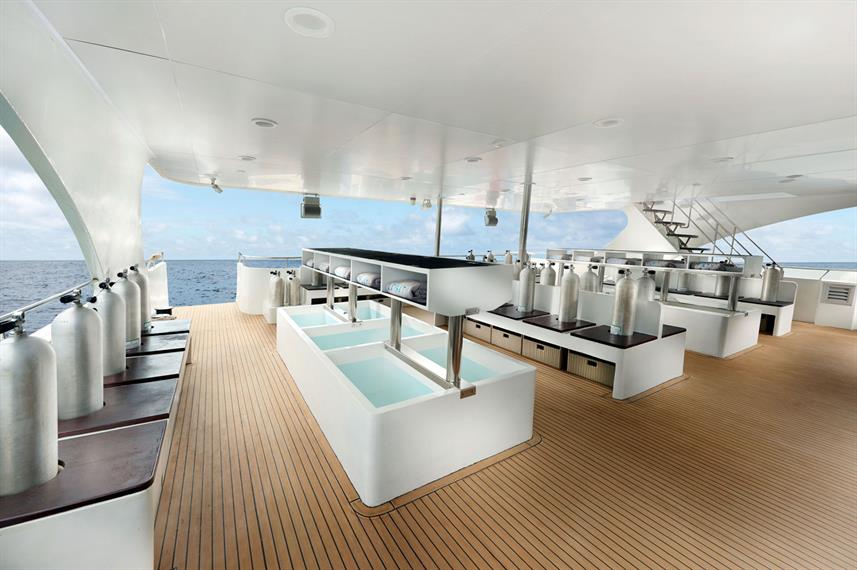
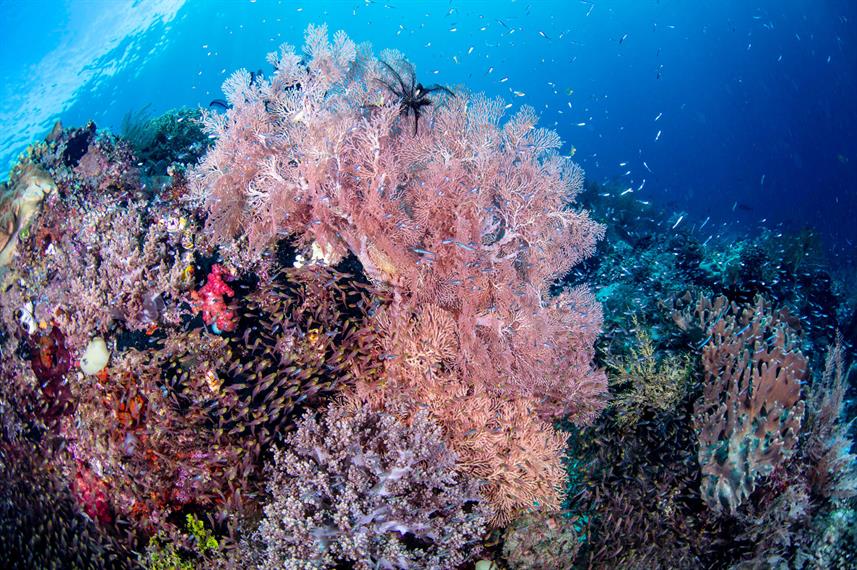
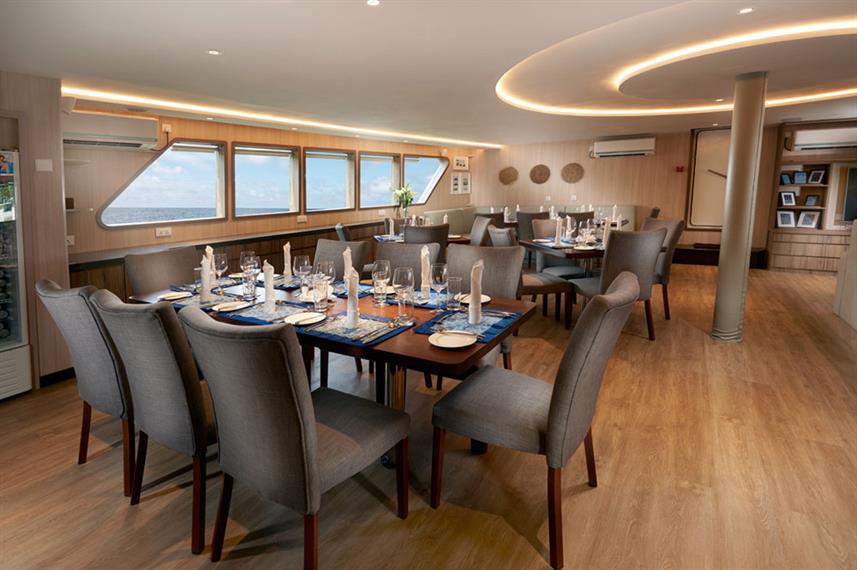
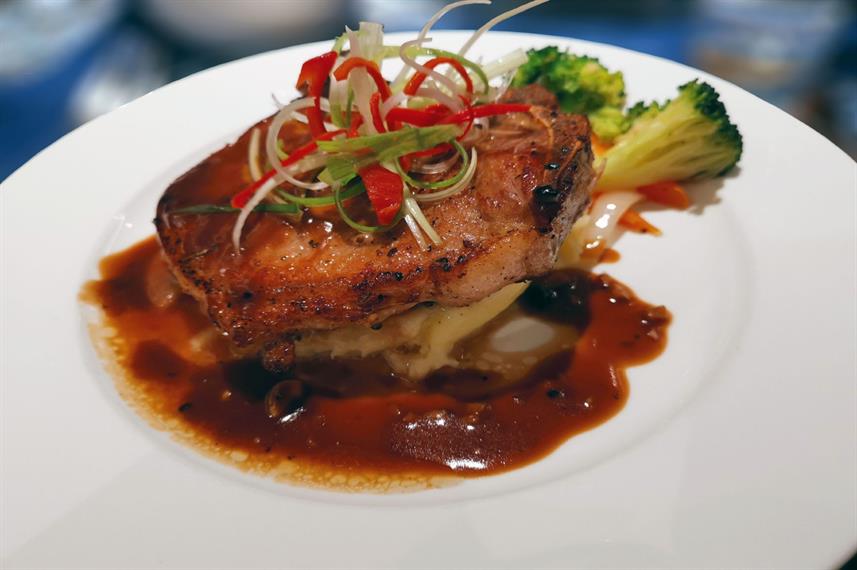
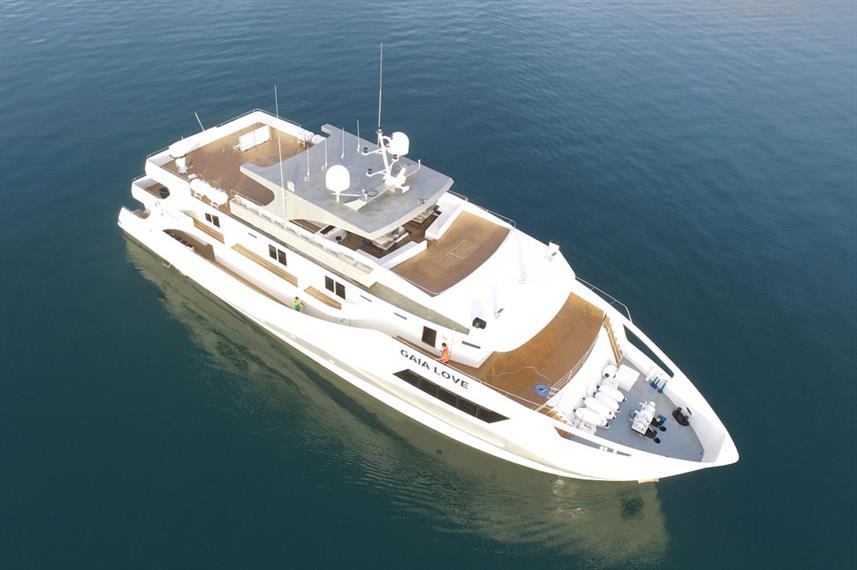
- Price: $$$
- 9 – 11 Night Trips = more diving!
- Modern Yacht
- Private Balcony Cabins
- Beaches, Treks & Komodo Dragons
Gaia Love is one of the very few Komodo liveaboards that is a modern yacht; this is very much represented in it’s contemporary interior design. At 40 meters long, this huge liveabaord has 4 decks including a massive sundeck, shaded outdoor lounge & al fresco dining, indoor dining and bar area.
Catering to a maximum of 22 guests, there are 11 cabins: all have ensuite bathrooms and are very spacious with an average size of 20 meters squared. The upper deck cabins also feature ocean view windows with private balconies.
It may be expensive but Gaia Love an extremely luxurious liveaboard – superb attention to detail has been paid in all regards – from the expertly prepared food to the incredibly attentive, friendly and helpful staff and the expertly planned dive itineraries.
Also, because trips last 9 – 11 nights, you will get to explore many more dive sites with Gaia Love compared to most other Komodo liveaboards which have shorter itineraries.
4) Wellness: Scubaspa Zen
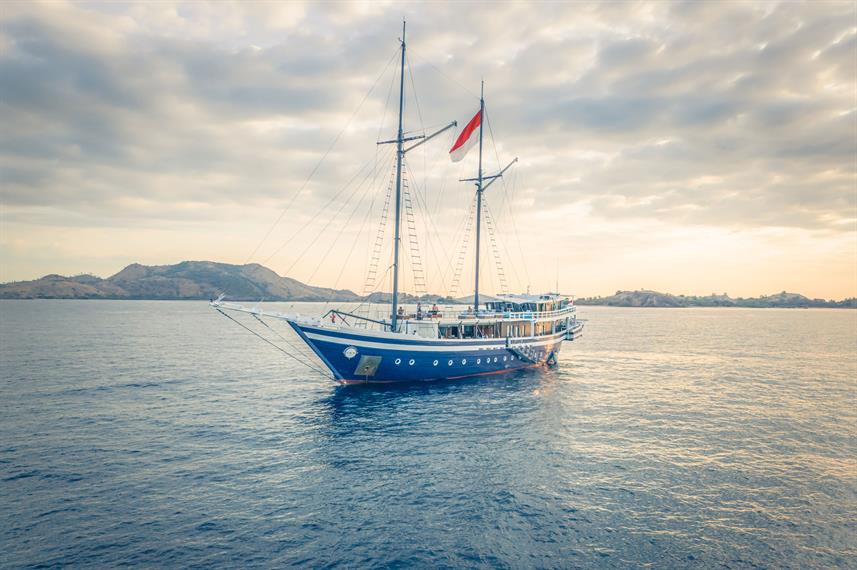

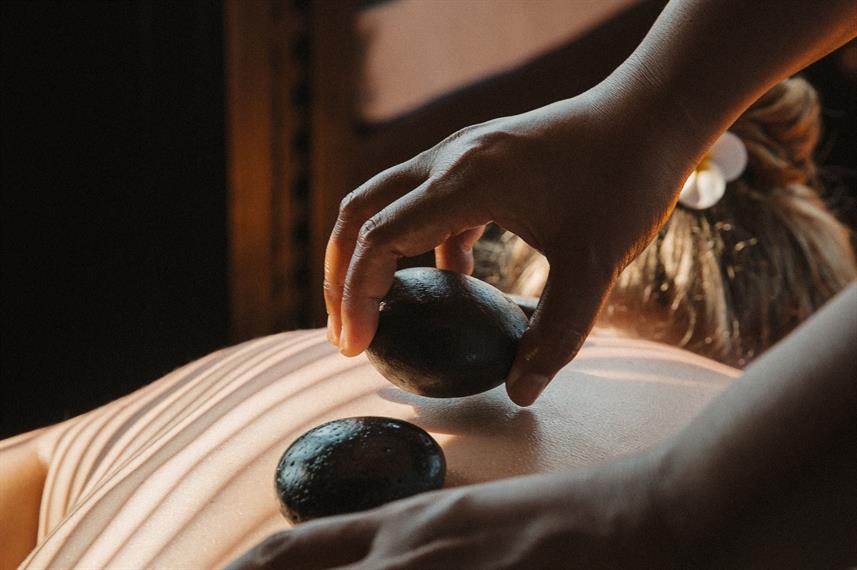
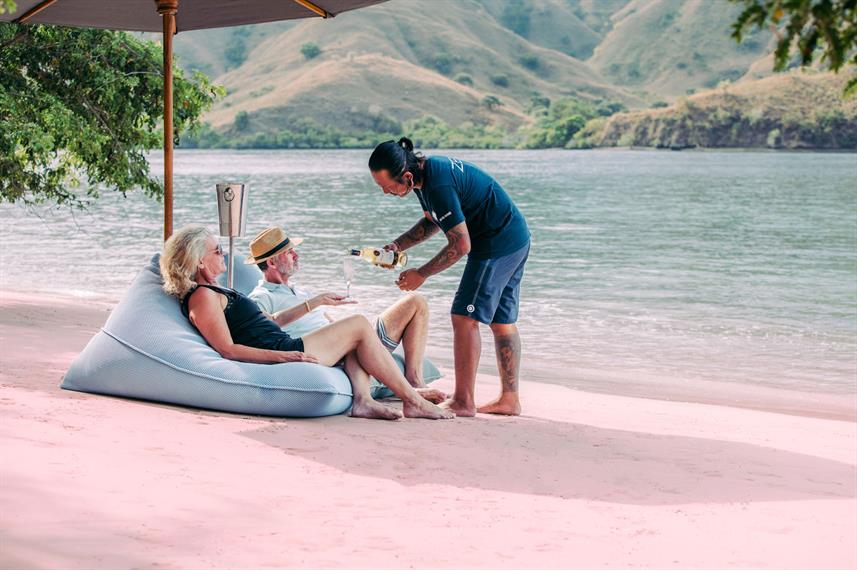
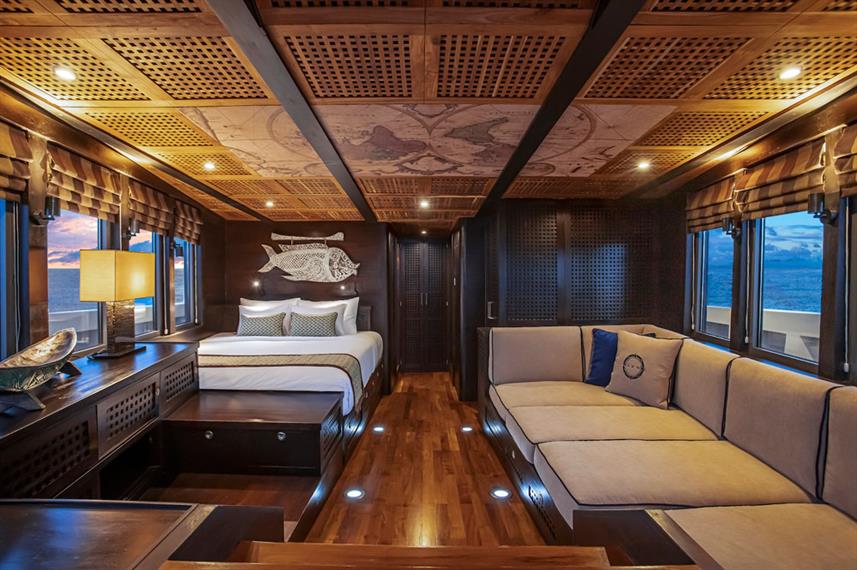
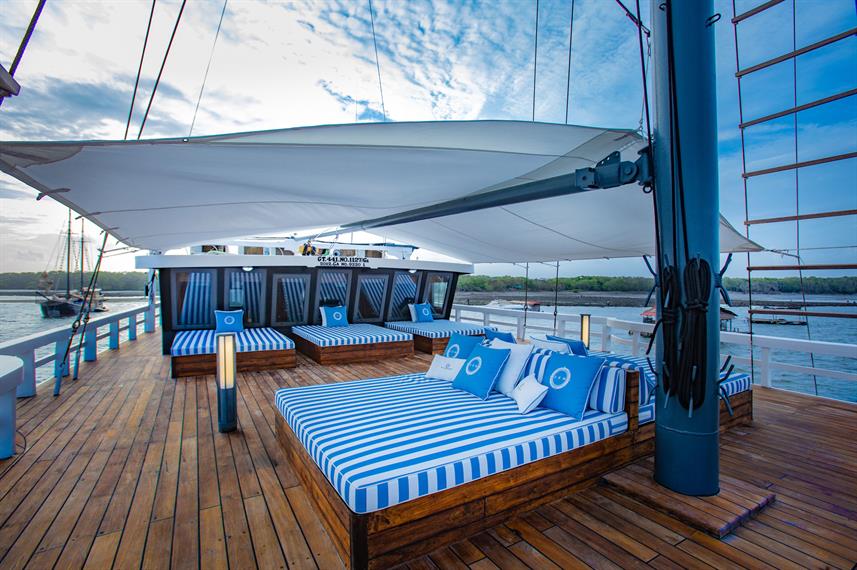
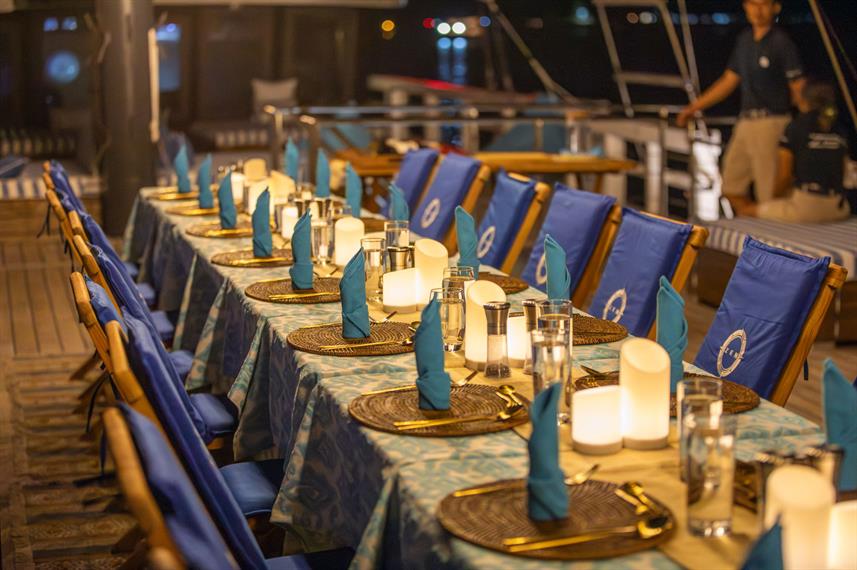
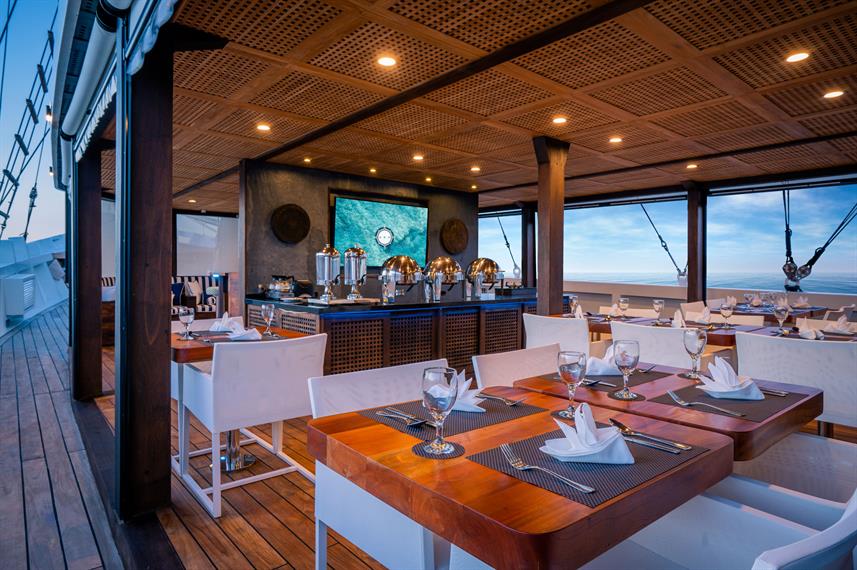
- Price: > $$$
- 7 – 10 Night Trips = more diving
- Guide Yoga AND 5 Star Spa
- Massive Cabin with Private Balcony
- Beaches, Treks & Komodo Dragons
Scubaspa Zen is a shiny new liveaboard that was launched in 2020 with the aim of offering scuba diving trips that also provide wellness activities such as guided yoga, spa treatment, beach excursions and next level healthy food.
At 53 meters long; this is an absolutely huge liveaboard (the biggest on our list!) yet caters to a fairly small group size of 18 guests. There is a 5 star spa onboard as well as al fresco and indoor dining, a spacious sundeck where you can do guided yoga, partially shaded outdoor lounge and the next level ZEN bar serving all manner of cocktails, wines, beers and spirits.
Theres 9 luxurious cabins with ensuite bathrooms and writing desks as handmade Balinese decorations, black teak and marble. Some cabins also have private balconies! The very largest cabin – the Owner’s Manta Suite is a whopping 60 meters squared and features private dining and spa treatment as well as speakers, sofa and panoramic views.
With trips lasting 7 – 10 nights, ScubaSpa Yen explores the Central, North and South regiosn of Komodo; the diving itineraries are very well planned out and feature some of the very best dive sites in all of Komodo and other parts of Indonesia. This is the only operator in Indonesia to offer a 2 boat service, with a separate 21 meter long diving Dhoni for up to 4 dives a day.
5) Best Komodo Liveaboard for Couples: Busy Girl
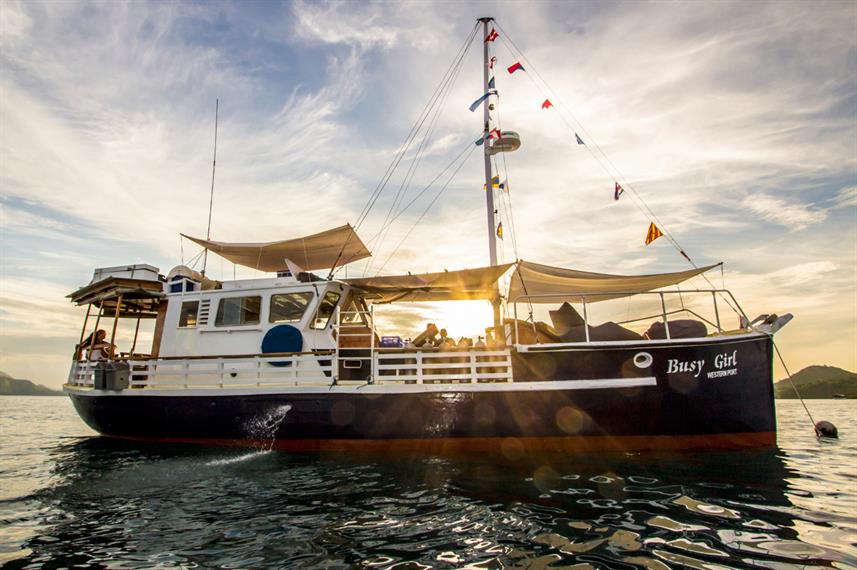
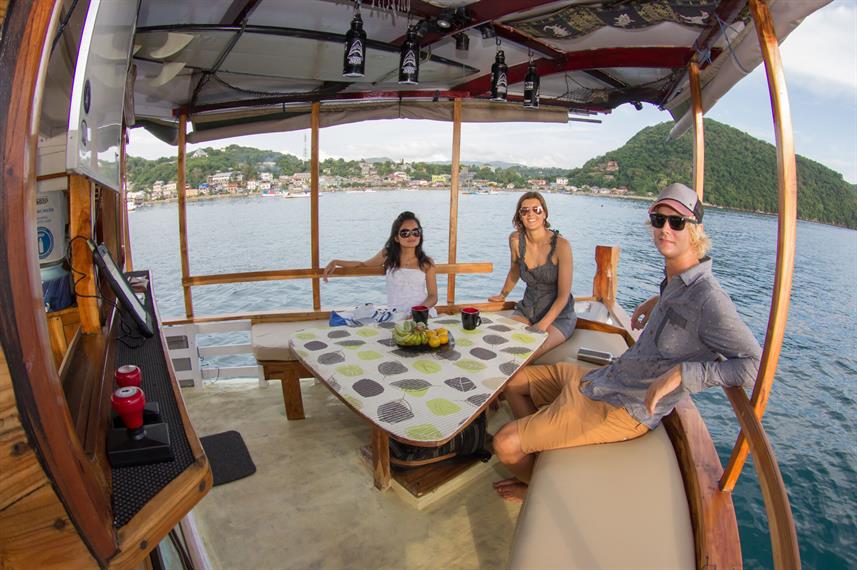
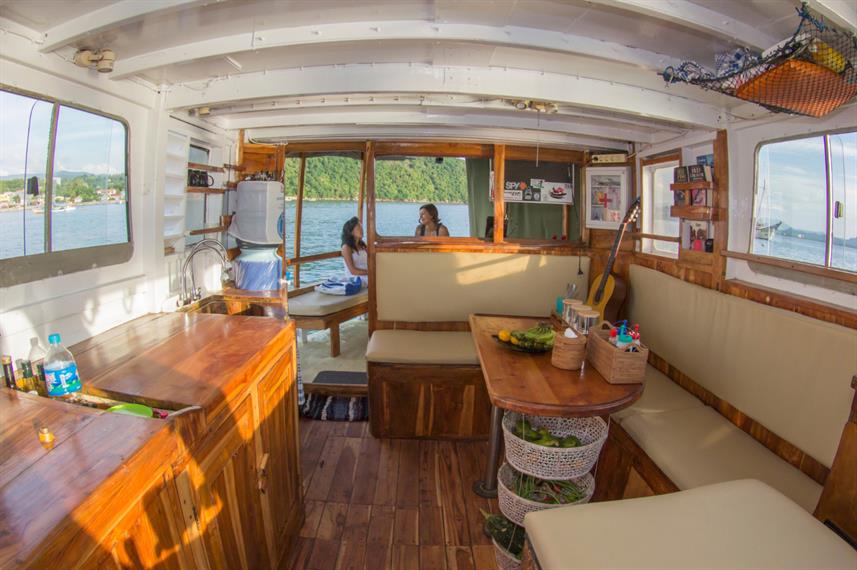
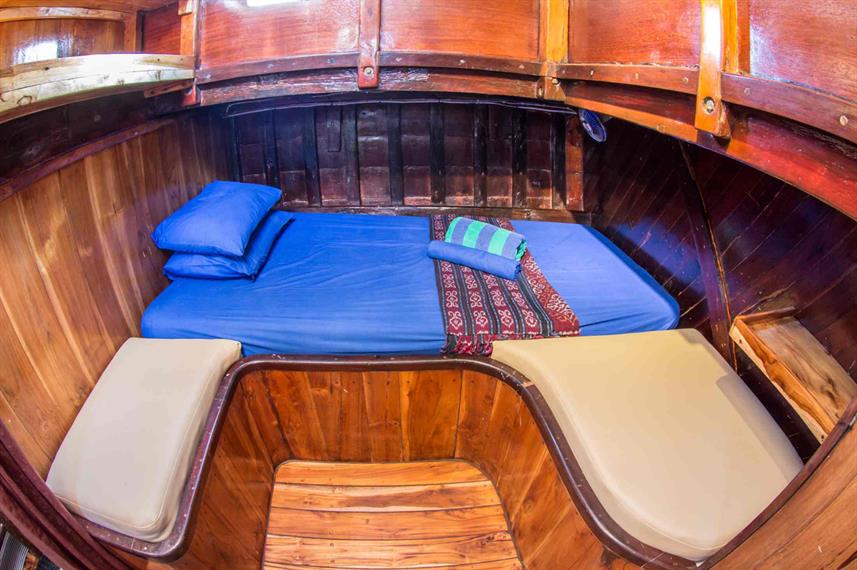
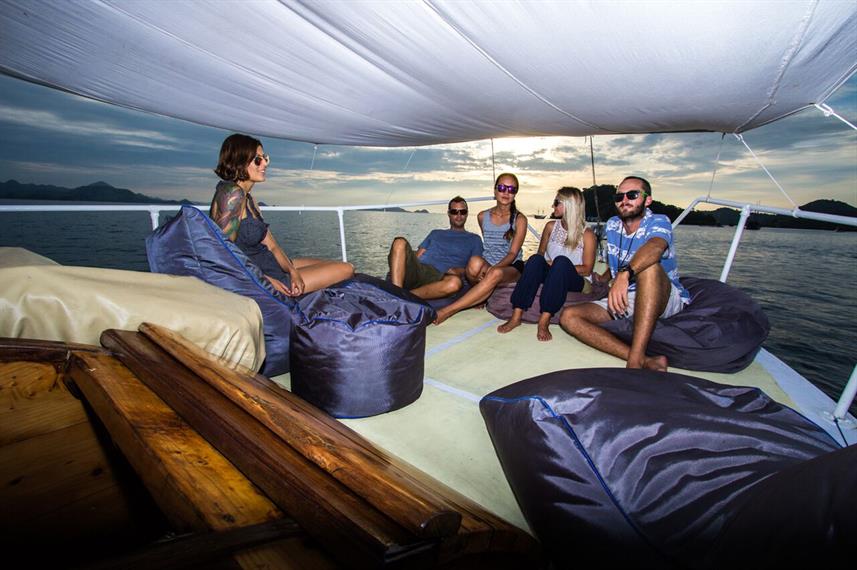
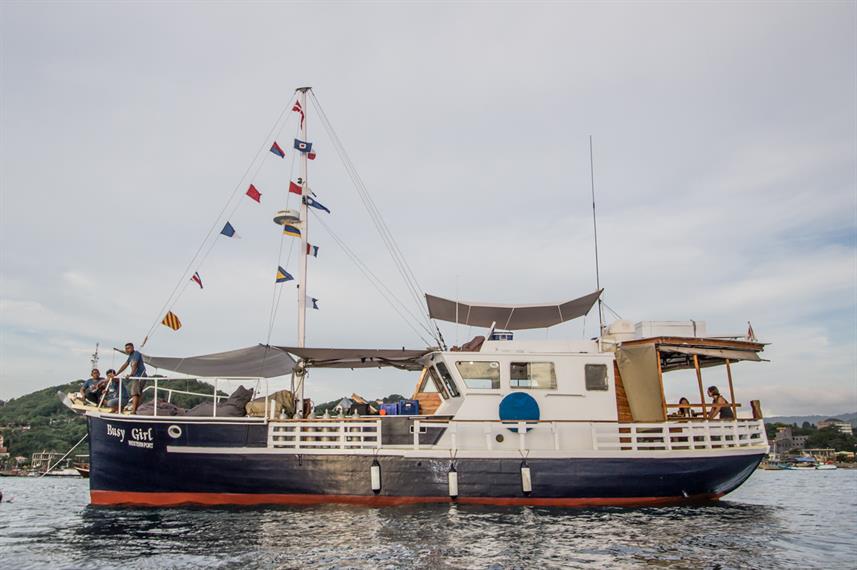
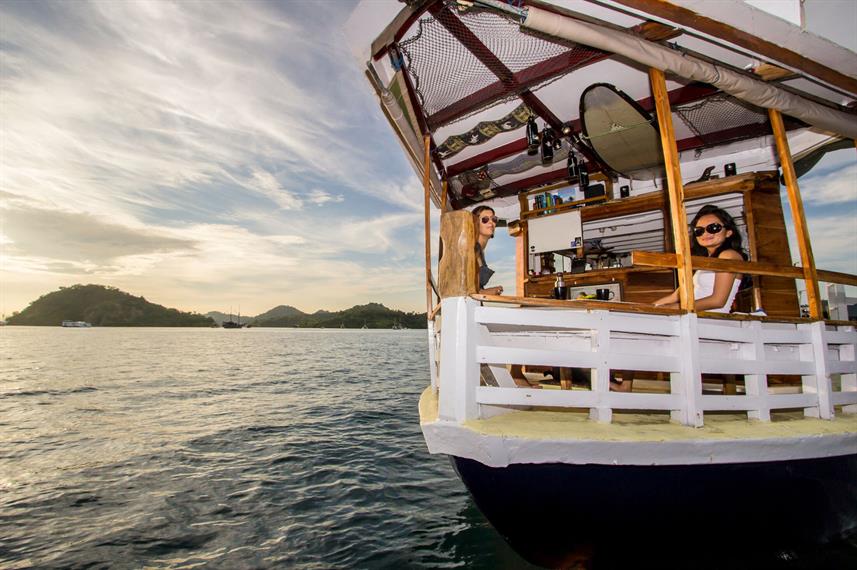
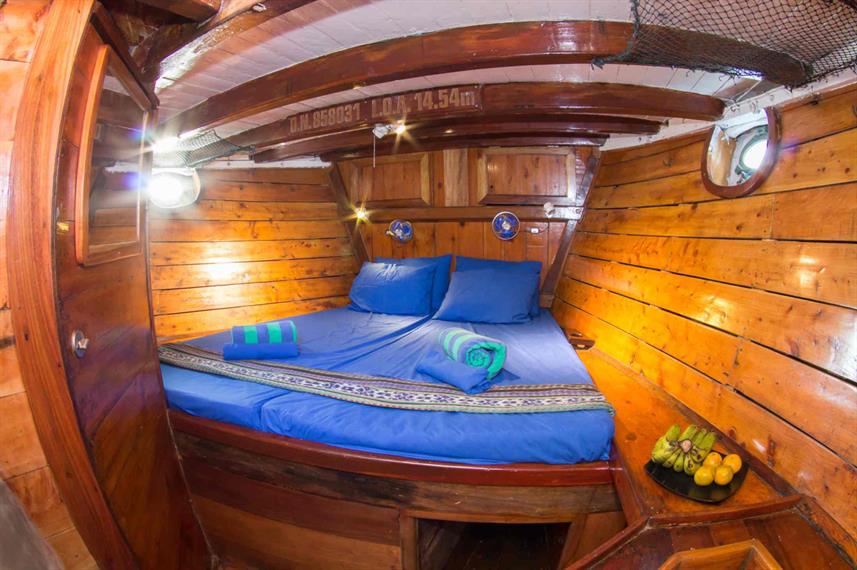
- Price: > $
- 2 – 4 Night Trips
- 4 Guests Maximum
- Komodo Dragon Visit (on 4 night trips)
If you’re a) looking for one of the cheapest Komodo liveaboards there is, b) seeking a short Komodo dive trip of just 2 – 4 nights and c) prefer to only dive with a couple of other guests… Busy Girl is your girl!
Taking a maximum of 4 guests, Busy Girl primarily explores the Central and North but sometimes also South regions of Komodo in mini dive safaris that last just 2 – 4 nights. Because of the low daily cost and short trips, no other Komodo liveaboard is as cheap as Busy Girl.
Also; there is a maximum guest size of just 4 – smaller than that of any other liveaboard making Busy Girl a great option for couples.
Small and basic though Busy Girl may be, this is still a nice…cosy liveaboard to stay on for few nights with two double cabins, two cute little outdoor chill out zones, an indoor dining area and even a teeny-tiny partially shaded sundeck up top.
6) Best Value Cabin: La Galigo
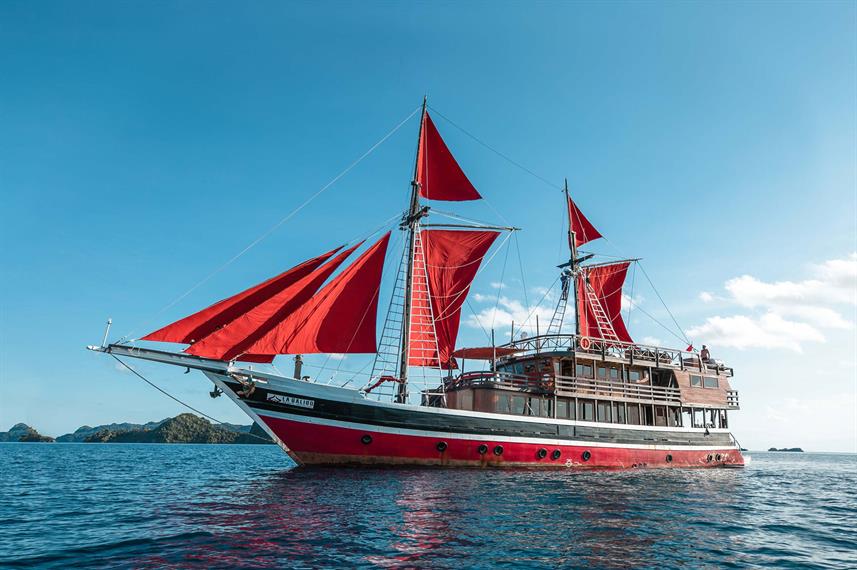
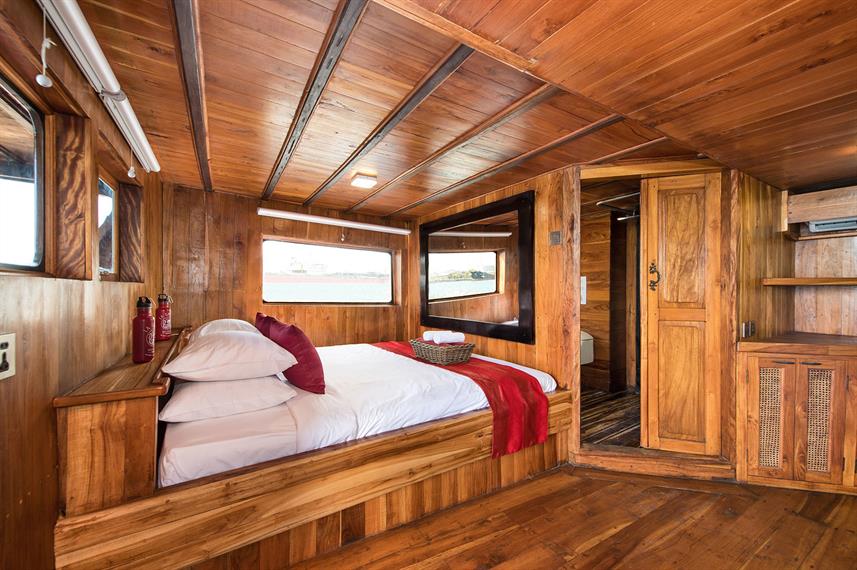
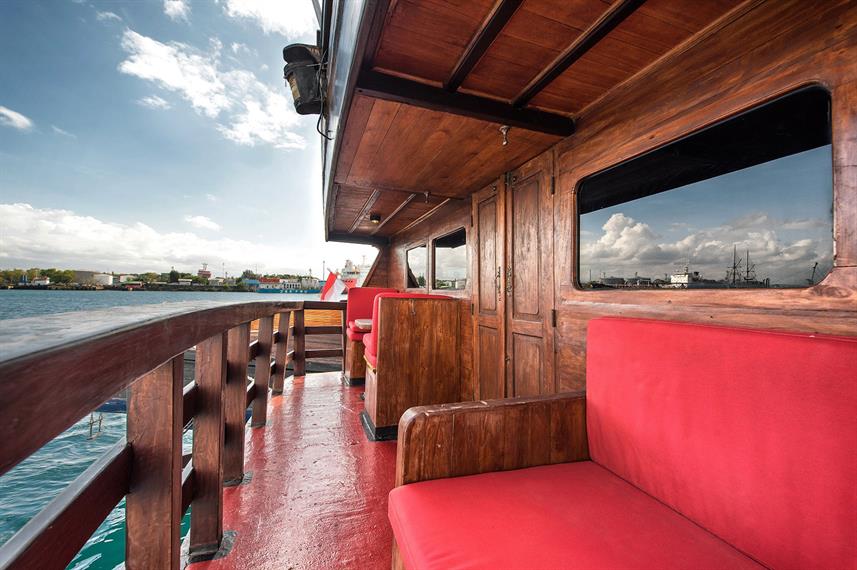
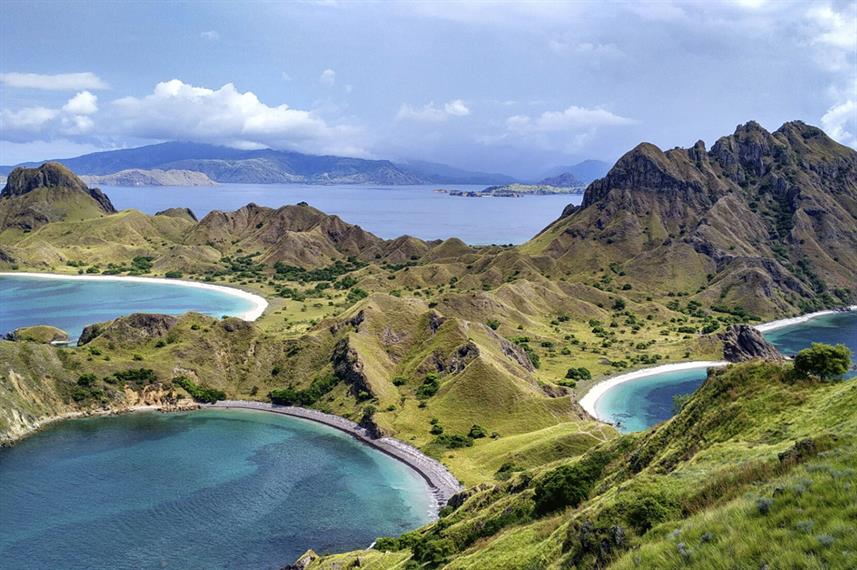
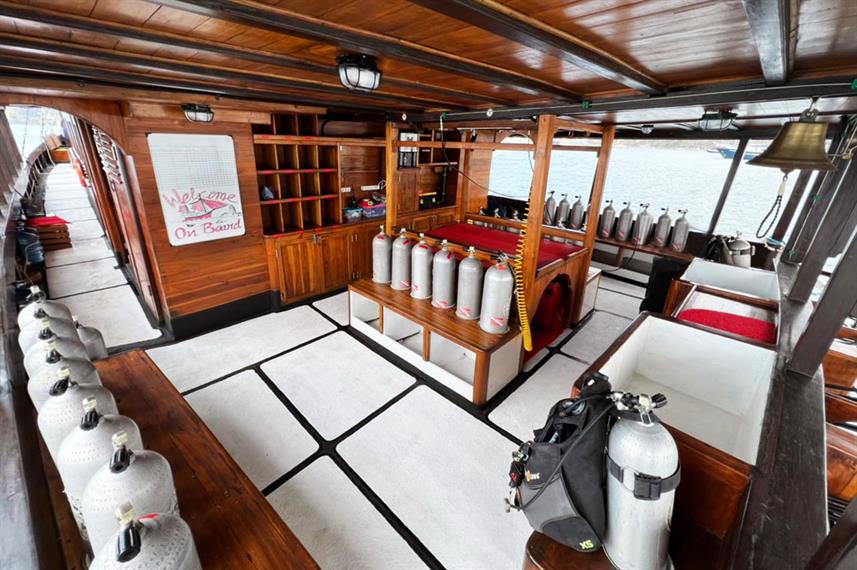
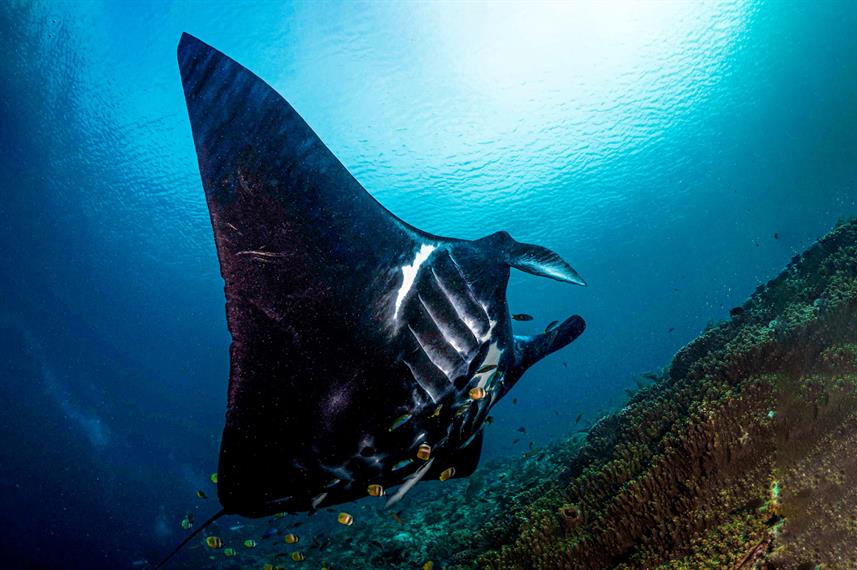
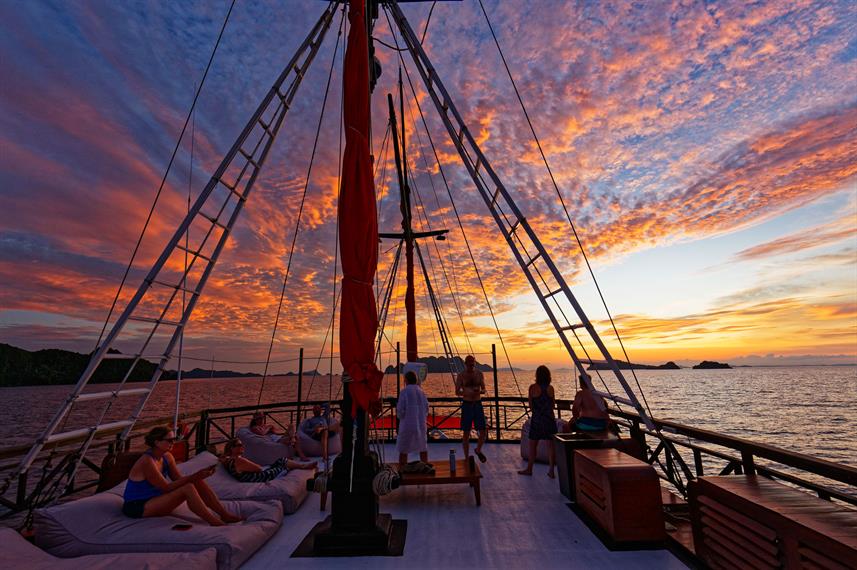
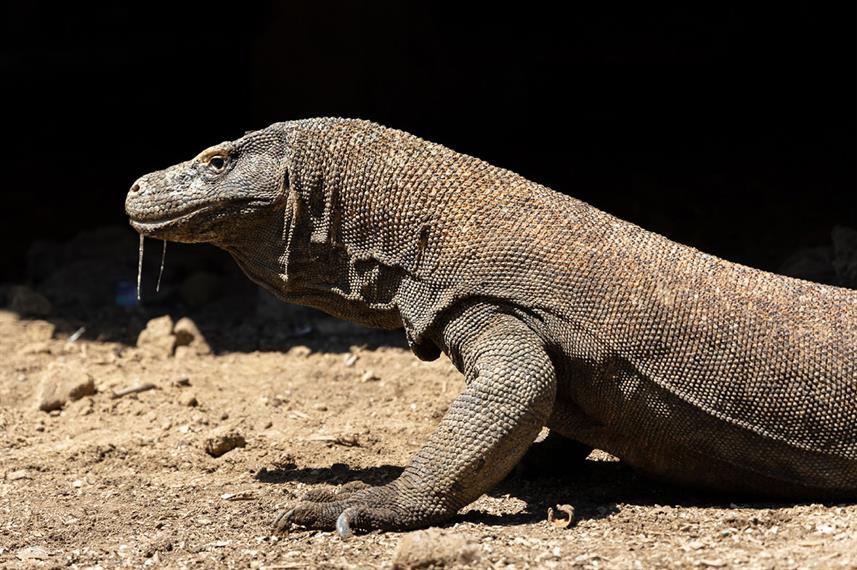
- Price: > $$
- 5 – 7 Night Trips
- Incredible “Suite” with Private Balcony
- Viewpoint Treks & Komodo Dragon visit
La Galigo may be only mid-priced compared to other Komodo liveaboards but it has a truly luxurious cabin: “The Suite” which comes equipped with a private balcony, sofas, minibar and HD 48″ TV. Normally, cabins like these are only featured on luxurious liveaboards that cost nearly twice as much as La Galigo!
Even if you don’t choose “the suite”; the other cabins are also extremely nice with beautiful hardwood interiors, ensuite bathrooms and in some cases ocean view windows.
At 33 meters long, La Galigo is a medium sized liveaboard; however because it takes a maximum of only 14 guests, it actually feels very spacious. There is a large sundeck, a partially shaded outdoor lounge and an indoor dining with TV, bar and library.
Operating 5 – 7 night long trips around all three of the major diving regions of Komodo: Central, North and South; trips with La Galigo also include viewpoint treks and a visit to the Komodo Dragon reserve on Rinca Island. At certain times of year this liveaboard explores other parts of Indonesia such as Raja Ampat.
7) Intimate Setting: Carpe Diem
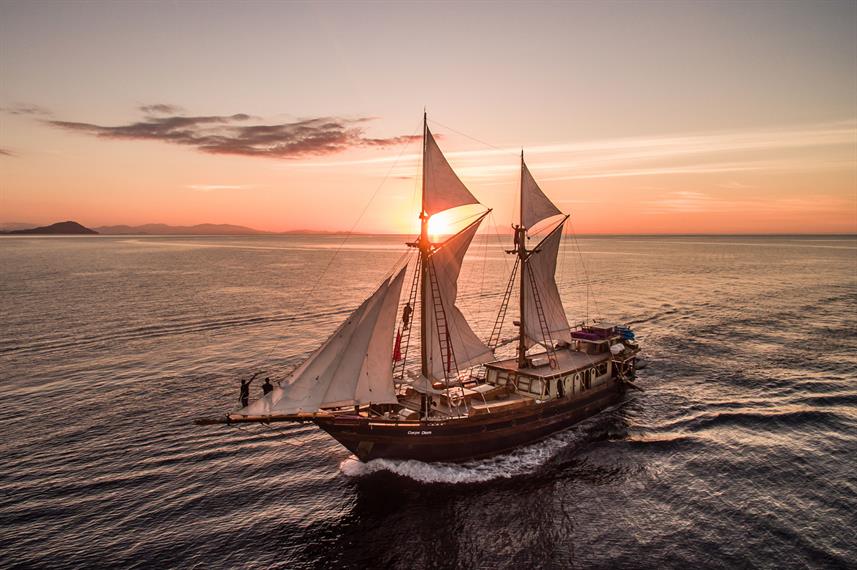
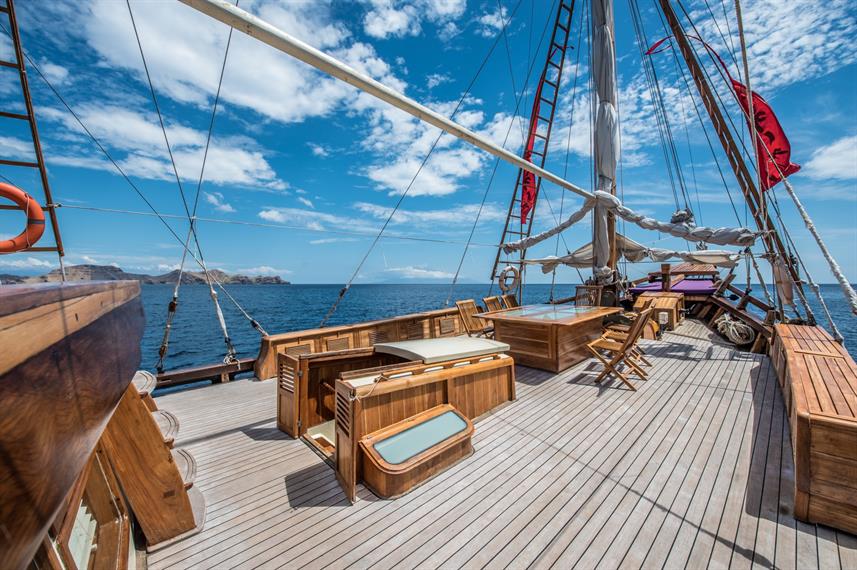
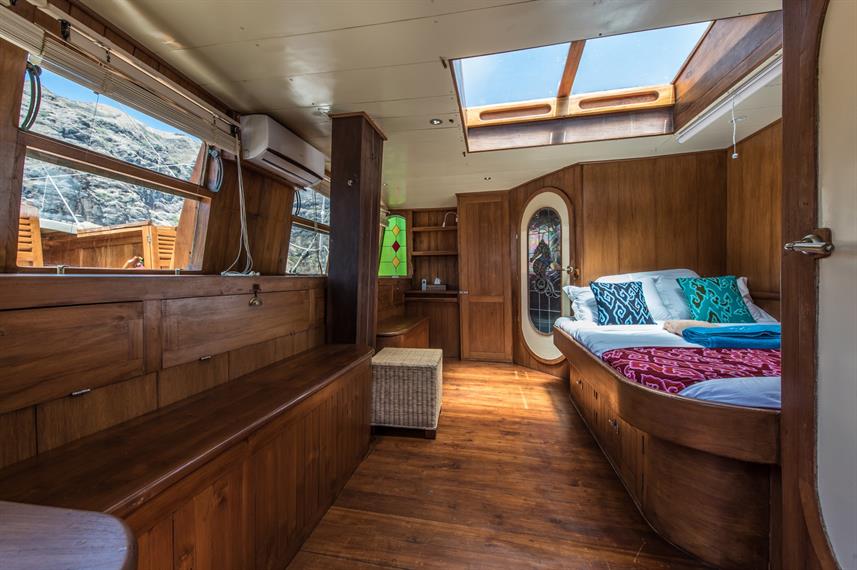
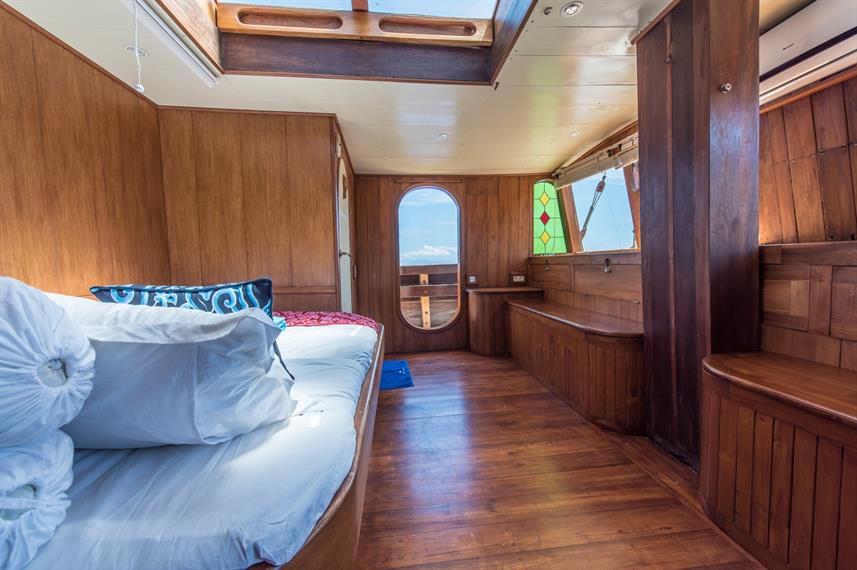
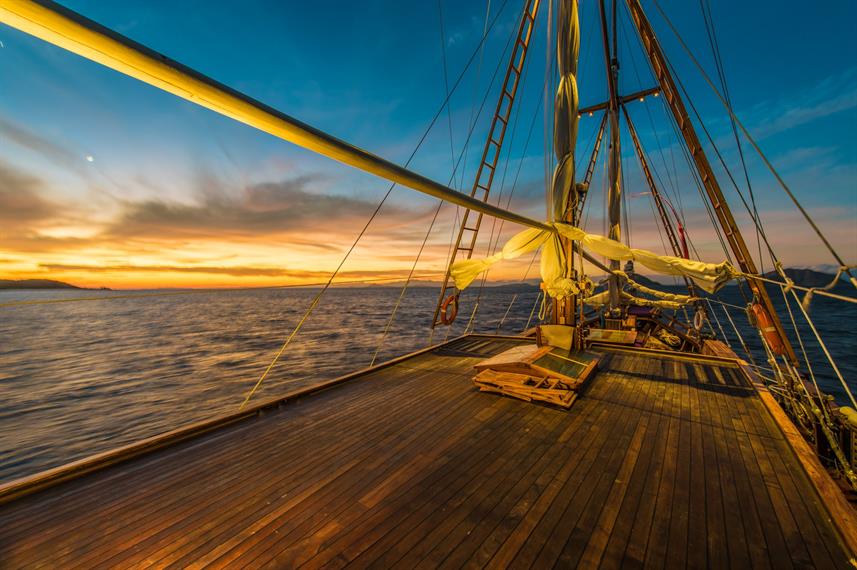
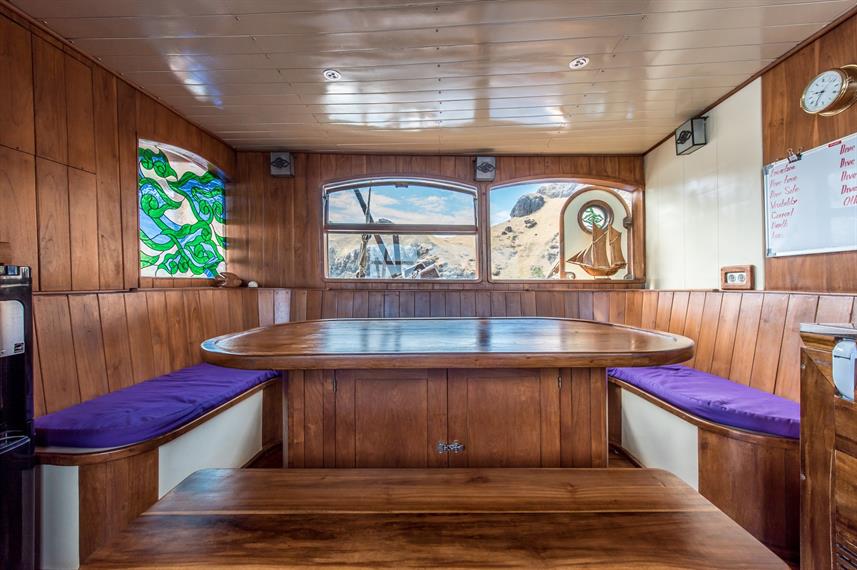
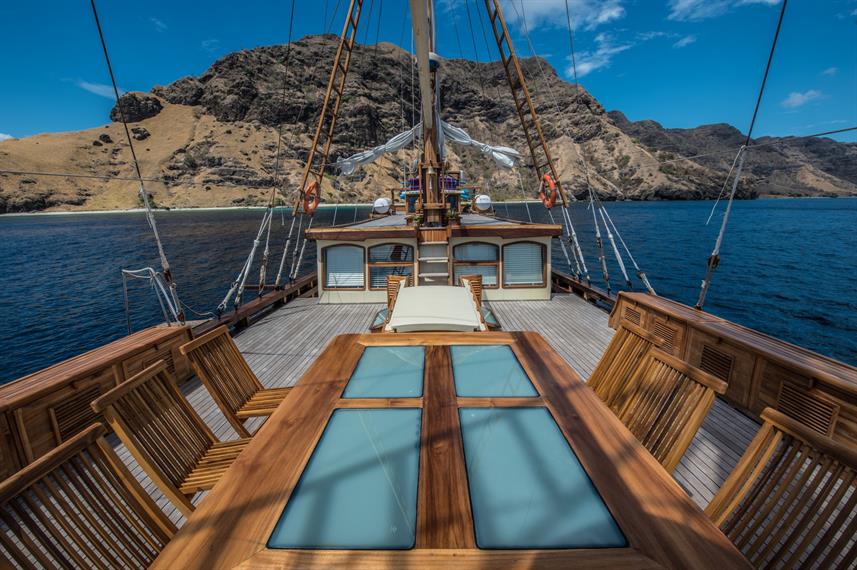
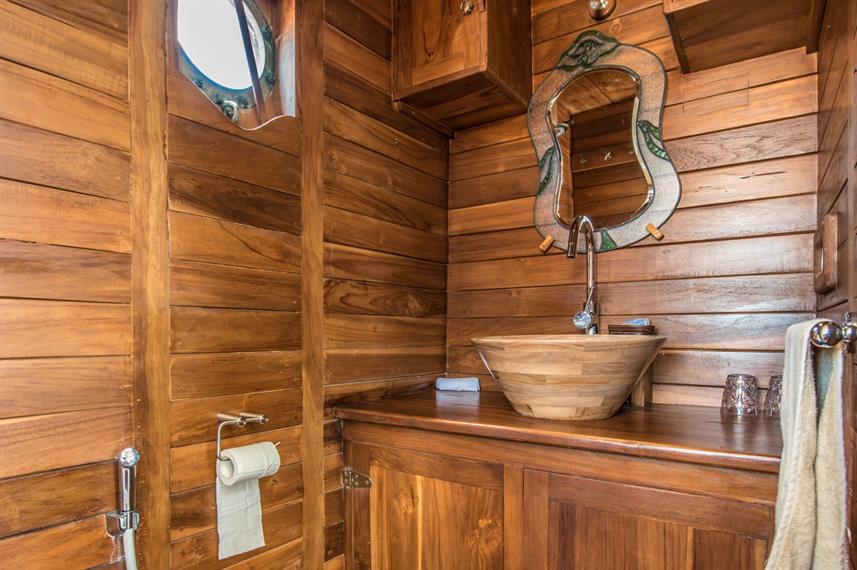
- Price: > $$
- 5 – 7 Night trips
- 8 Guests Maximum
- Beautiful Liveaboard with Intimate Setting
Another mid-priced liveaboard that feels like a luxury one, Carpe Diem is a beautiful traditional Phinisi vessel that measures 35 meters long.
Carpe Diem has been designed to create an intimate and personalised service for small groups; taking a maximum of 8 guests in 4 cabins. The largest cabin: “The Nutmeg” spans almost the entire width of the boat and features a skylight for star watching. The other cabins feature double, single and triple bed options.
Carpe Diem operates 5 – 7 night long trips around north and central Komodo Marine Park. There are also several other itineraries that combine Komodo diving with other nearby Indonesian destinations such as Banta, Sengeang and Bima or which explore entirely different regions like Raja Ampat.
8) Best Budget Option: Queenesia
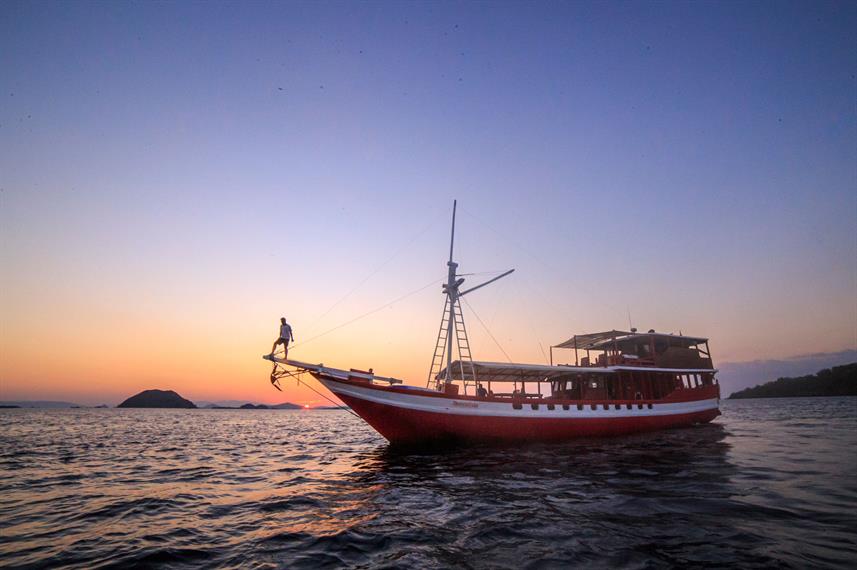
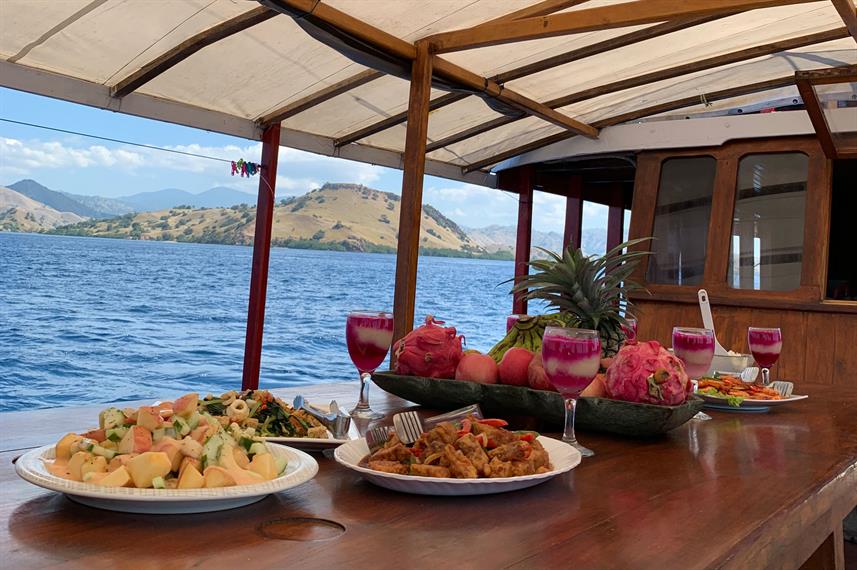
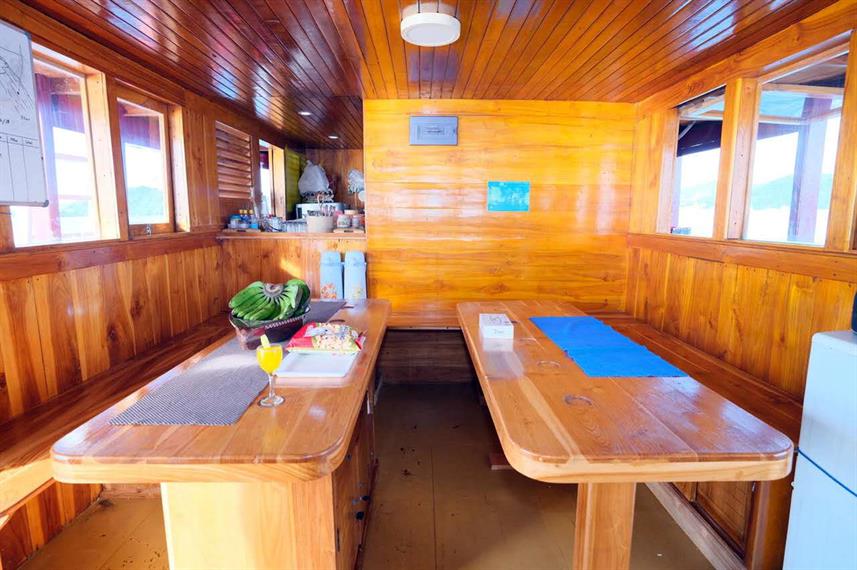
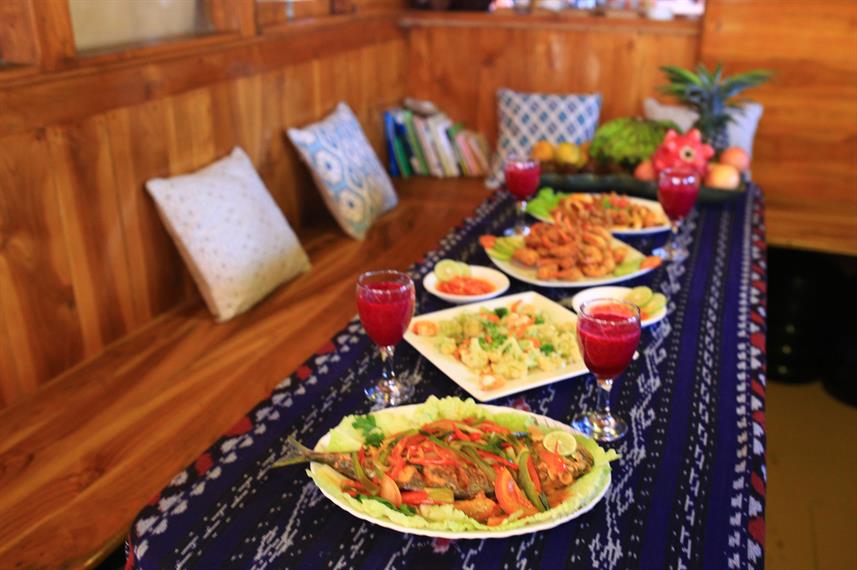
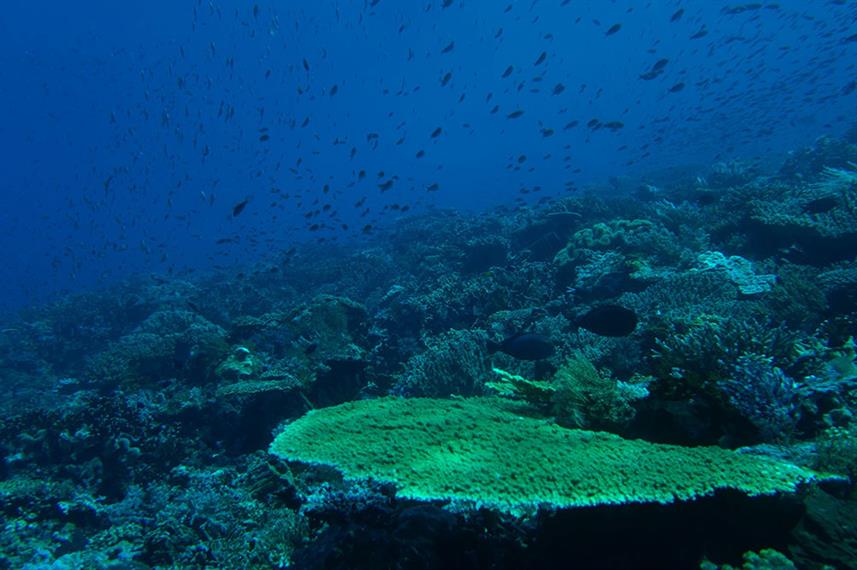
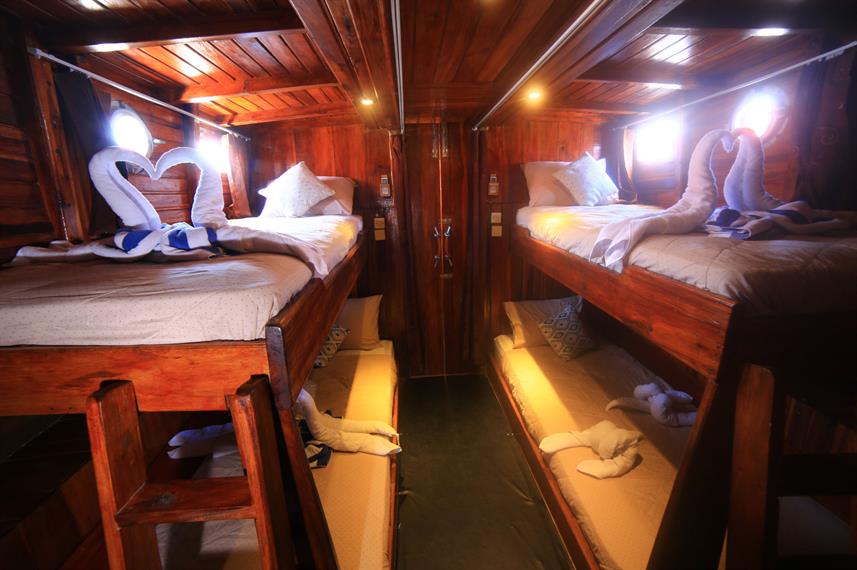
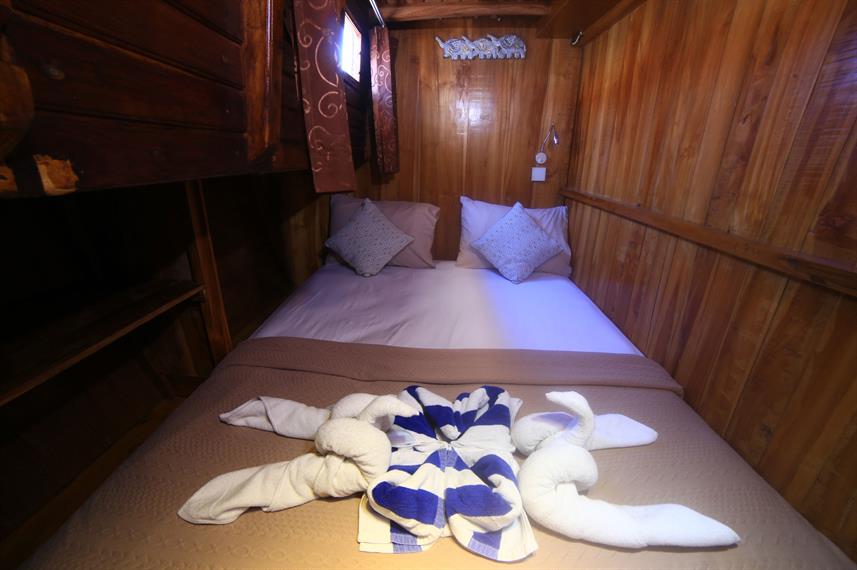
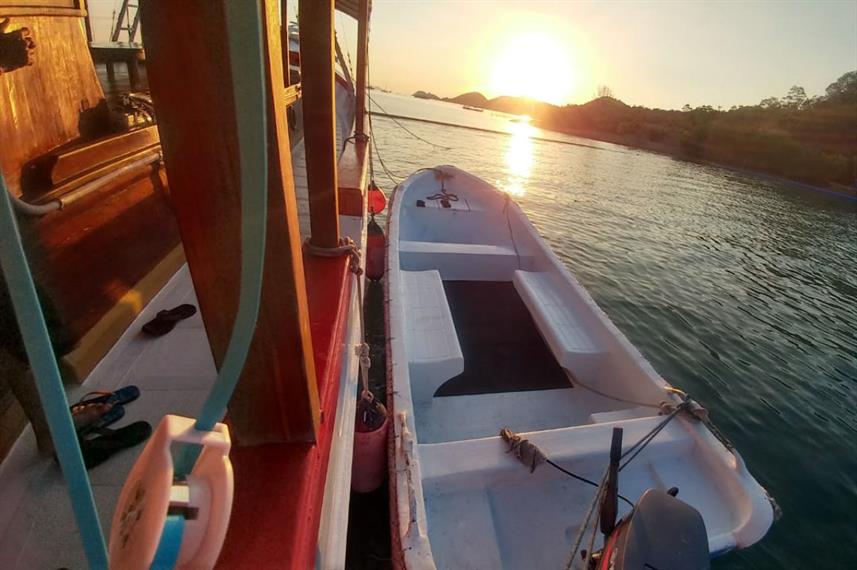
- Price: > $
- 5 Night Trips
- 8 Guests Maximum
- Komodo Dragon visit
Designed for the budget-diver, Queenesia is one of the cheapest Komodo liveaboards out there. Catering to a maximum of 8 guests, there are 3 cabins: a double cabin, a twin cabin and a quad cabin (ideal for a family or group of 4!).
At just 22 meters long, Queenesia is what some would describe as a “cosy” liveaboard; there is a small outdoor lounge and dining area on the main deck and a cute little partially shaded sun deck up top.
Staff and crew are all very friendly with experienced dive guides and a very talented chef who is more than happy to prepare customized food dishes to guests tastes.
Queenesia operates 5 night long diving trips around Komodo; trips also feature viewpoint treks and a Komodo Dragon visit on Rinca Island.
9) Shortest, Cheapest Trips: Nusantara
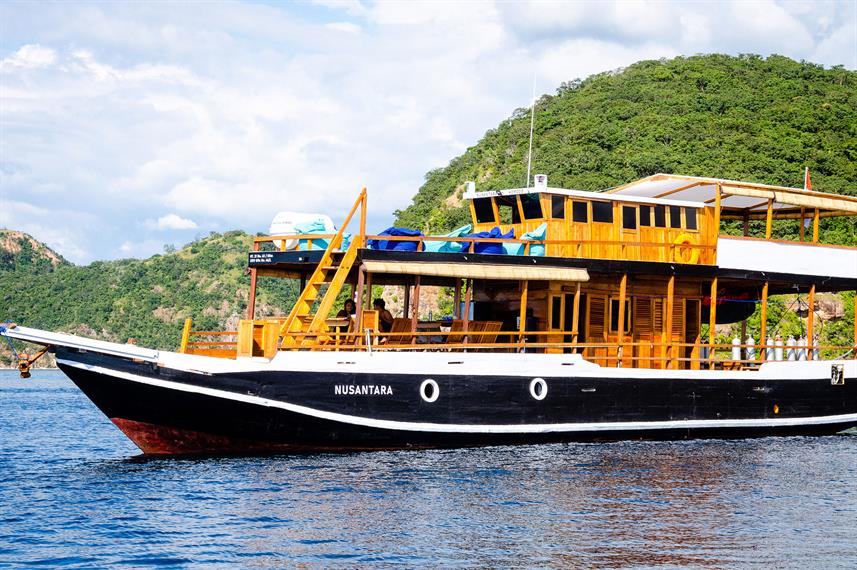
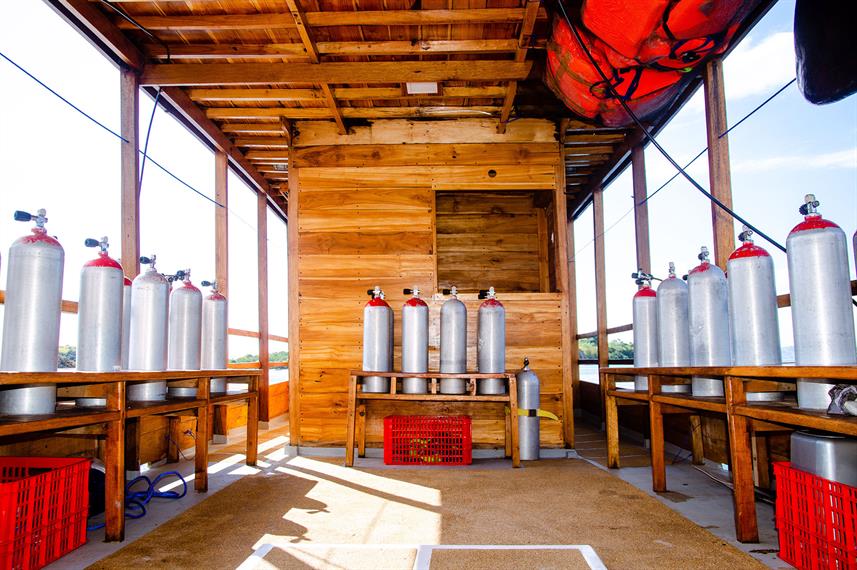
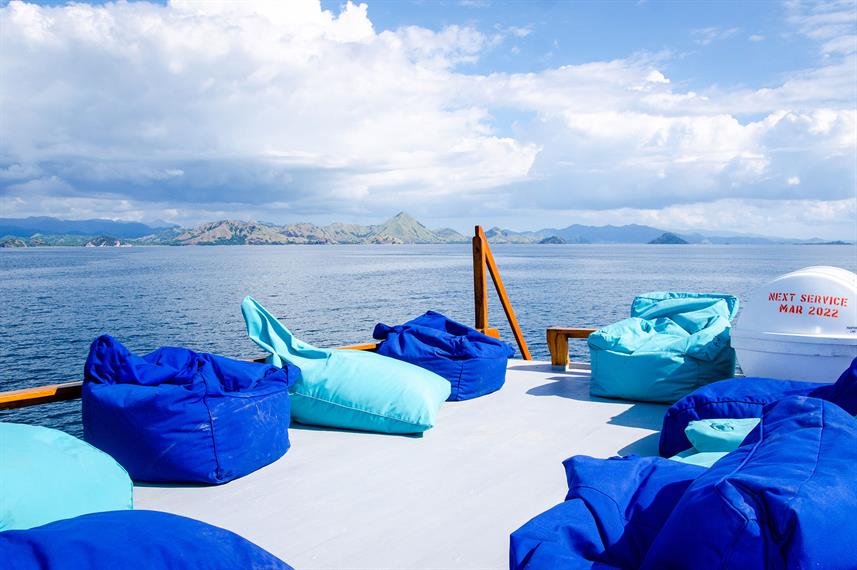
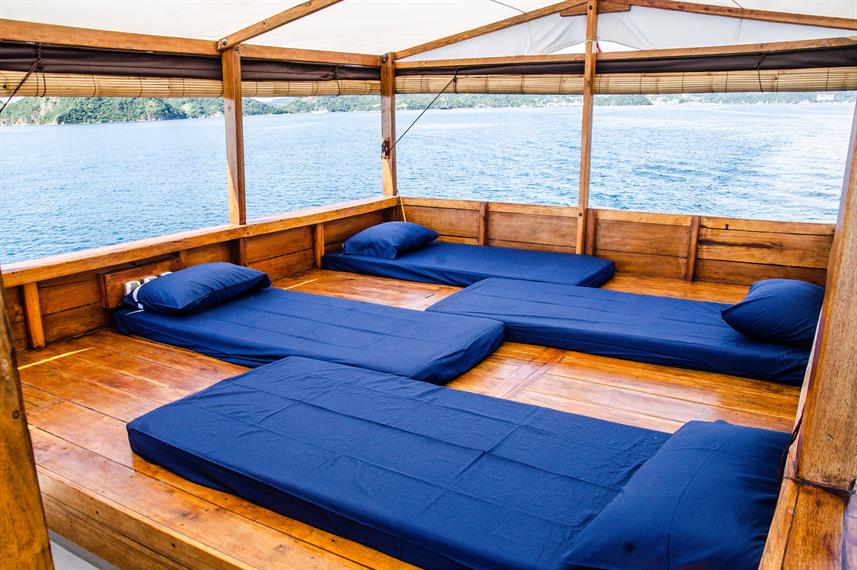
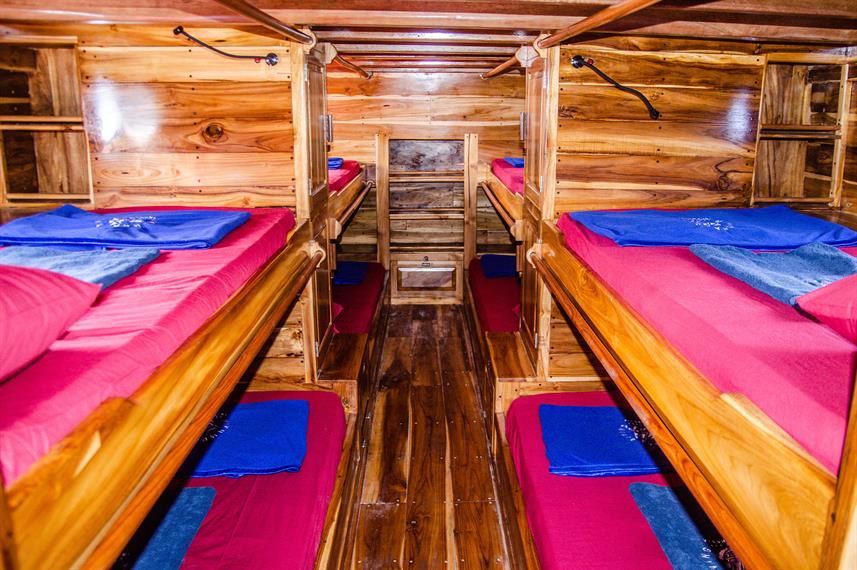
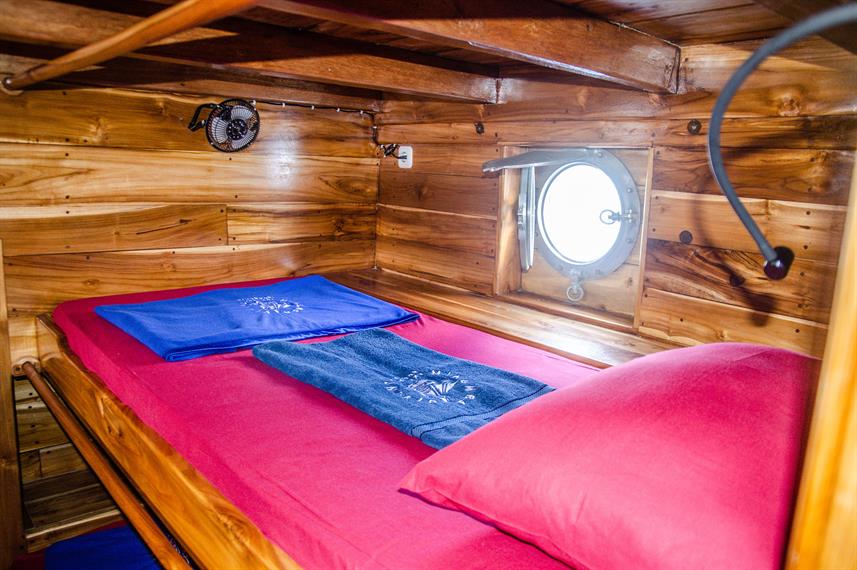
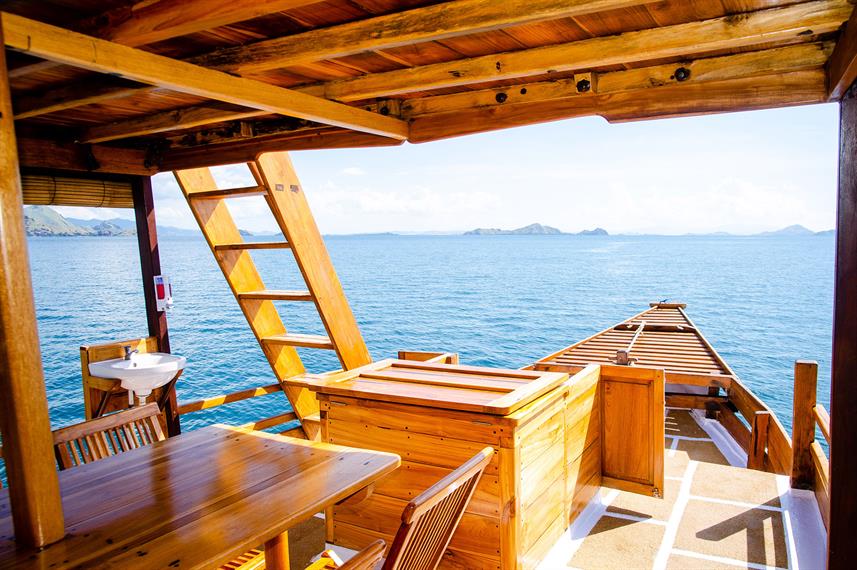
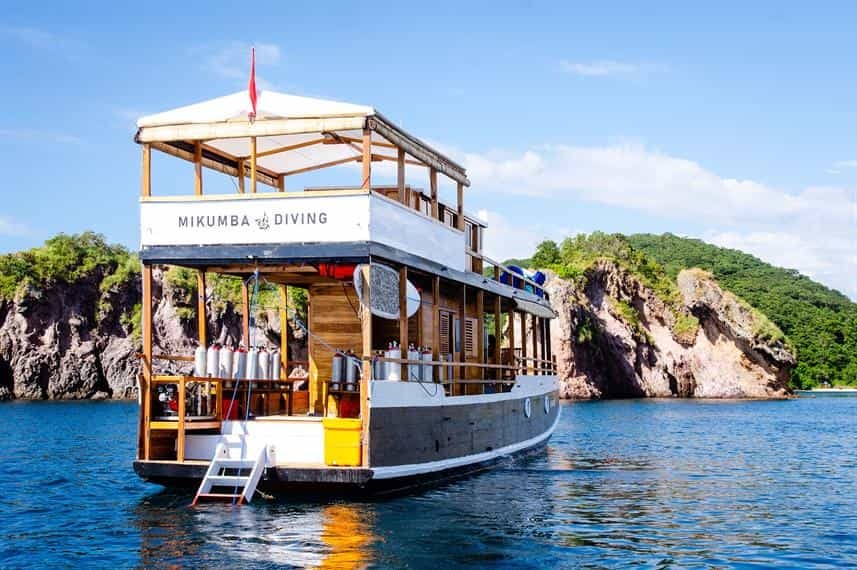
- Price: > $ (Cheapest Komodo Liveaboard)
- 2 – 3 Night Trips
- Dorm Cabin
- Social, Backpacker Vibes
Nusantara is more like a floating backpacker hostel than a liveaboard! It’s a great option for cheap and short diving trips within Komodo Marine Park.
The shared sleeping arrangements also make this a very social liveaboard to go on. There is a dorm cabin catering to 8 guests in single bunk beds – everyone has a privacy curtain, fan and charging outlet. Another 4 mattresses allow guests to sleep on the top deck beneath the stars.
Trips last just 2 – 3 nights and cost less than those of any other Komodo liveaboard we know of. Guests can expect 9 – 15 dives per trip around some of the very best Komodo dive sites like Manta Point, Batu Balong and Wainilu. Just be aware that unlike on other Komodo liveaboards, viewpoint treks and a visit to the Komodo Dragons are not included with Nusantara.
At 20 meters long, Nusantara features a partially shaded sundeck, outdoor lounge, indoor salon & dining area and a spacious dive deck. A great option for those tight on time and money!
10) Small Groups & Chill Vibes: Ecopro Dayung Baru
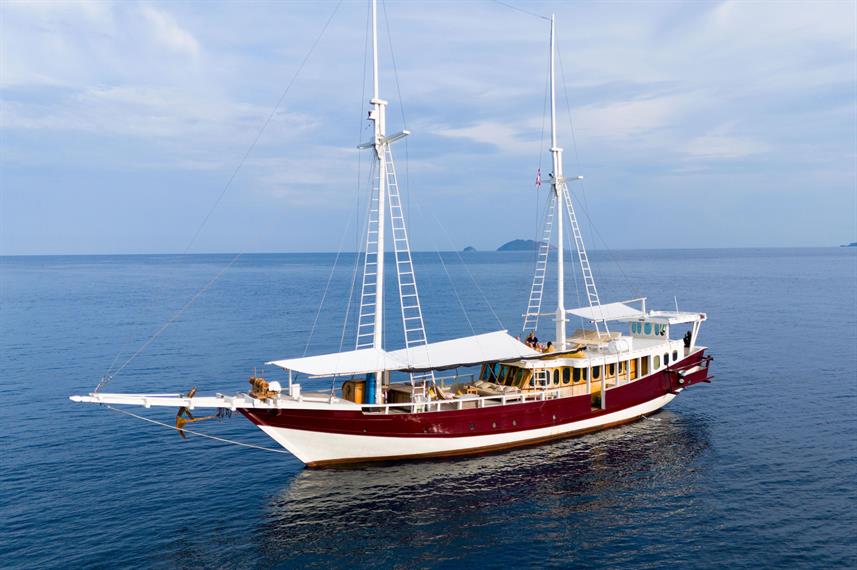
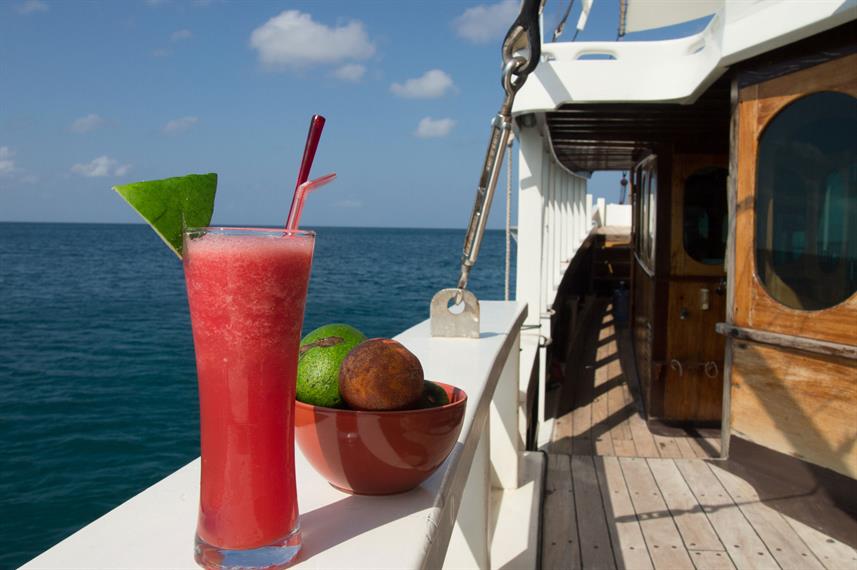

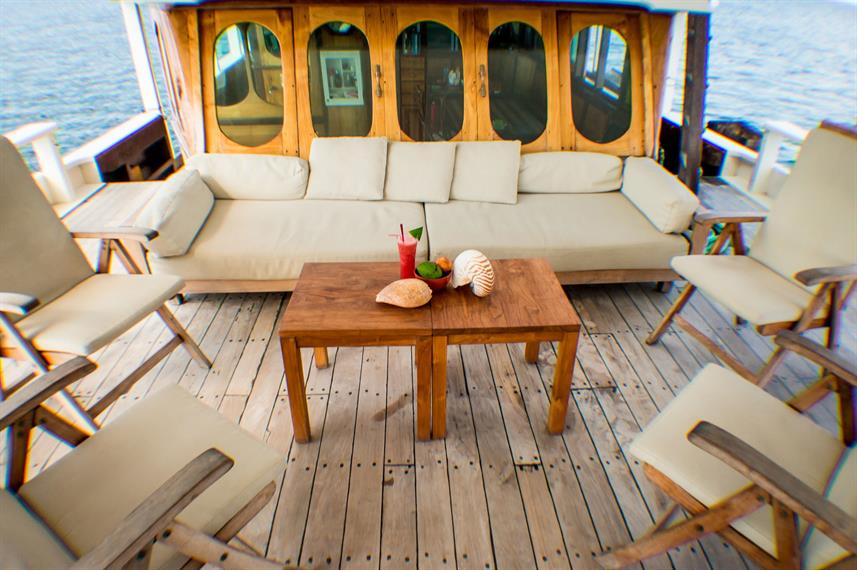
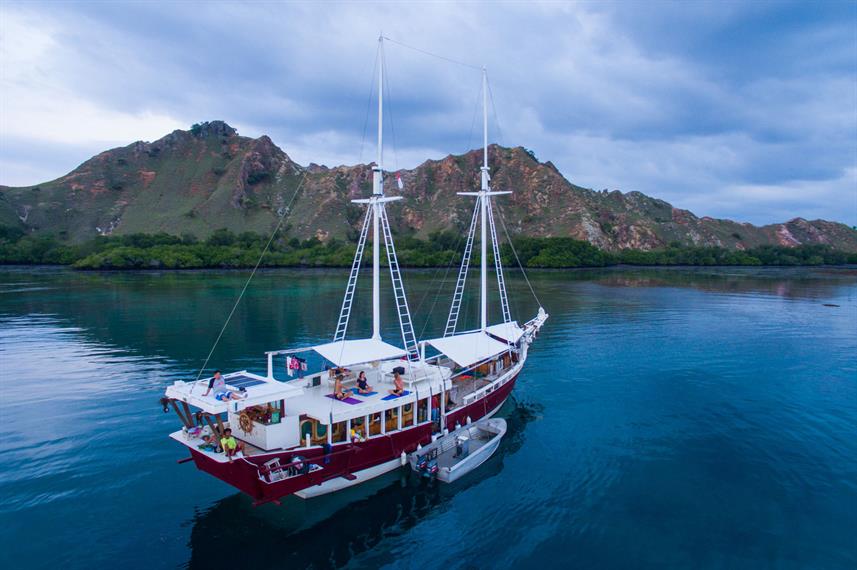
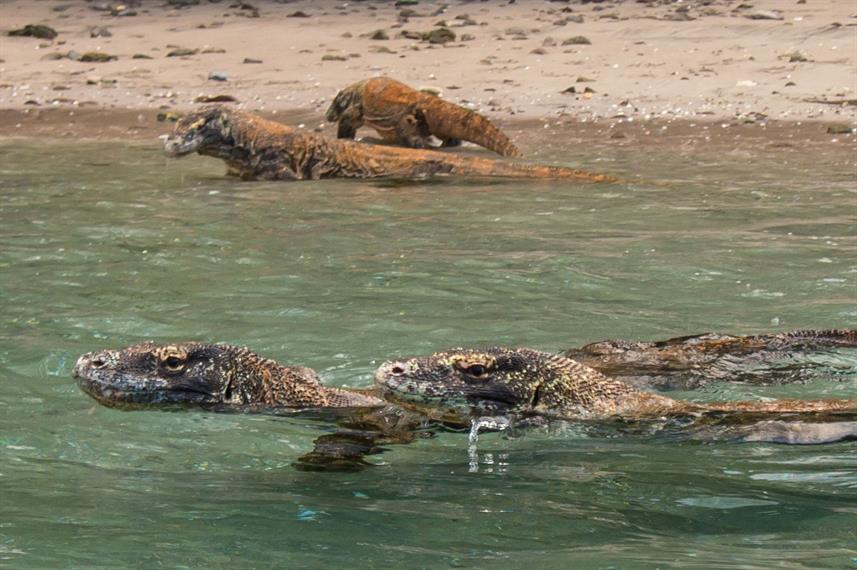
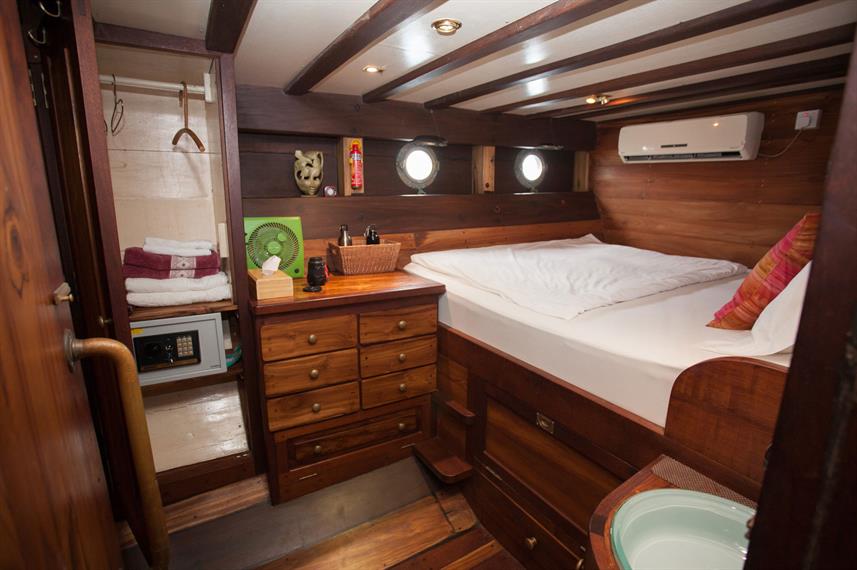
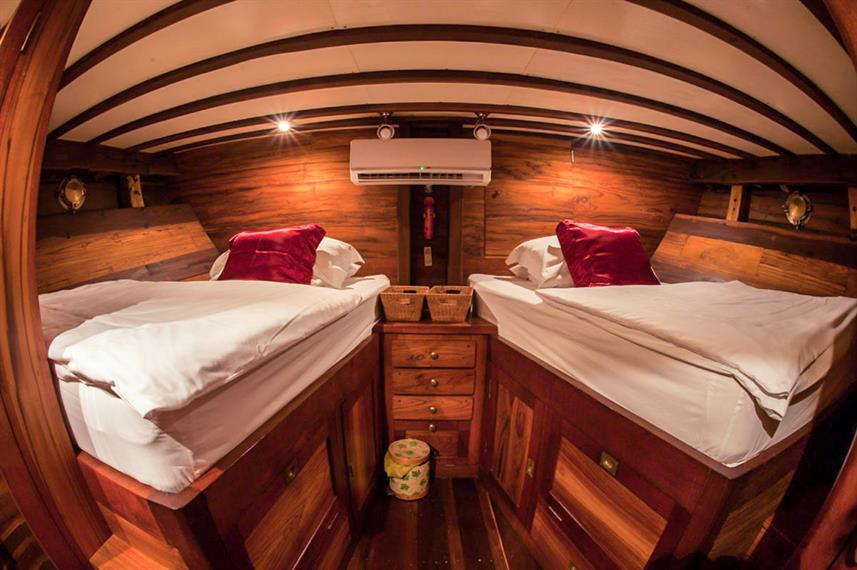
- Price: > $$
- 3 – 7 Night Trips
- 6 Guests Maximum
Ecopro Dayung Baru has just 3 cabins onboard, catering to a maximum of 6 guests for a personalised experience. Cabins are available as double or twin and all have an en-suite bathroom, porthole windows, hardwood interior and air conditioning.
The most popular common area is the partially shaded sundeck; complete with beanbags; most folks head up here at the end of the day to enjoy a drink, soak in the views and recount their days diving adventures with one another. There is also an outdoor lounge and dining area as well as indoor bar and dining zone.
It’s said that “the heart of the Ecopro Dayung Baru lies in the kitchen where fresh food is prepared all day. With an Indonesian theme and hints of Western flavours, guests can enjoy freshly prepared meals and snacks throughout the day”. Nice!
The dive guides are very experienced and knowledgable they have an epic knowledge of the many marine lifeforms you will witness. Ecopro Dayung Baru operates 3 – 7 night long dive safaris in Komodo that besdies diving, include a variety of extra activities.
Komodo Diving Info:
For a comprehensive look at what it’s like diving at Komodo, check out this Diving in Komodo Guide!
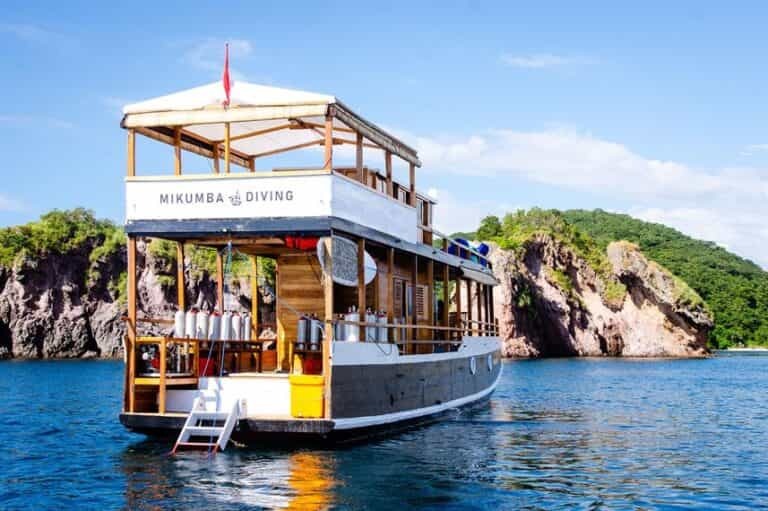
Komodo Regions & Routes
There’s a considerable variety of potential routes offered by Komodo liveaboards. This is due to the three distinct regions of Komodo: north, central and south as well as the national park’s proximity to dive sites around various other Indonesian islands, which are sometimes also visited by “Komodo” liveaboards, despite being technically outside of komodo.
Most liveaboards offer a variety of routes, which usually visit a combination of:
- North Komodo: This area is known for having the most dramatic underwater landscapes in the entire national park; with towering pinnacles, underwater caves and rocky drop offs. There is some splendid hard coral covering said underwater landscapes and due to the strong currents, many pelagics are attracted here, including manta rays, reef sharks and various large fish.
- Central Komodo: This is the main region of the National Park and also the most varied. You’ll encounter small macro critters, many manta rays and countless turtles. Sometimes, dolphins and whales (seasonal), can be spotted here to. The absolute best variety of hard coral is found around the central region. Although most dives are drift dives, a few areas experience more gentle currents, making several dive sites beginner friendly.
- South Komodo: The least visited region, south Komodo is a great place for drift diving, with everything from whale sharks to mola mola / sunfish and even the occasional dugong. Although there is some hard coral in the southern region, here the reefs are mostly comprised of soft coral and sponges.
You can find out much more information about the regions of Komodo by checking out this page all about Komodo National Park.
Liveaboards that explore just Komodo or only a few nearby extra areas (Banta and Sangeang, which you can read about below), tend to depart and finish at Labuan Bajo, a coastal town on the western side of Flores island, in East Nusa Tenggara province.
Areas outside of Komodo:
Whilst most liveaboards only explore the Komodo region; some of the routes offered by a few, also include visits to additional dive sites outside the national park. A liveaboard route can spend anywhere from 10 – 50% of the time in these other regions. More info is provided in the reviews section.
To the West of Komodo:
- Banta – Consisting of deserted beaches and rugged mountains, Banta island (aka Gili Banta) is found some 10km northwest of Komodo. The island itself can be trekked and offers stunning views of Komodo and Sangeang. The waters around Banta are famous for big creatures like Mobula Rays, Eagle Rays and many types of sharks, with most dives being of the drift variety. Because of Banta being close to Komodo National Park, it’s the most commonly visited extra area and only takes a day to include in a liveaboard’s itinerary.
- Sangeang – The next most frequently visited extra area and lying 25km northwest of Banta, is Sangeang island; home to the visually stunning volcano of Mt. Sangeang; which it’s worth visiting for the epic views alone. The waters around Sangeang mainly give way to muck diving; with all manner of weird and wonderful species including wasp fish, octopus and devilfish; amid blazes of red and green coral and hydrothermal vents.
A fair few liveaboard visit Sangeang and/or Banta, before turning back, to Komodo. In this case, these liveaboards start and finish at nearby Labuan Bajo. However, others liveaboards offer routes that visit Banta and Sangeang, before continuing on to start or finish the itinerary at either:
- Bima – Bima is a city located on Sumbawa island, in West Nusa Tenggara Province. It’s the departure or end destination on some liveaboard routes. There’s a variety of great dives around Sumbawa island, including Moyo island and Santonda island, both of which offer great muck diving.
- Lombok – Situated between Bima and Bali, Lombok is the starting or finishing point of some liveabords. There’s a variety of dive sites around here, including drift, muck and wall dives.
- Bali – Bali is probably the most well known part of Indonesia right now and is legendary amongst digital nomads, fitness freaks and online entrepreneurs.
To the East of Komodo:
- Maumere – A beautiful bay on far east Flores, Maumere offers some great macro dives. There’s also a variety of diving areas between it and Komdo, along the north side of Flores, with a variety of great drift dives. The main advantage of staring or finishing at Maumere is it allows you to explore the rest of Flores, with a variety of tribal homestay experiences and treks being close by.
Diving Season of Komodo
It’s possible to dive at Komodo National Park all year round! That said, different parts of the year do offer different experiences:
- May-September: Prime diving season. This is generally the driest and hottest portion of the year for a sizeable chunk of Indonesia, including the north and central regions of Komodo and is therefore, one of the best times to dive as water conditions are very clear and calm. In the southern region however, water conditions are more choppy, with less visibility during these months. You have the best chance of spotting Mola Mola (Sunfish) on August.
- November – April: Monsoon season. This marks a period of rainy and volatile weather in the north and central region. However, at this time water visibility is actually at it’s best in the southern region. The increase in rain can reduce visibility but that doesn’t stop many divers from visiting during these months! Your liveaboard will adjust the route accordingly to take you to the best dive sites for the time of year and the weather on each particular day.
- December – February: During these months, plankton blooms attract many manta rays from far and wide, making this the best time to witness mantas in abundance. This is also the best period for spotting whale sharks.
For a much more detailed look at the Komodo National Park diving season, take a look at this komodo diving guide
How to Get to Komodo
This will depend on whether your liveaboard departs from Labuan Bajo, Bali, Bima, Lombok or Maumere. Many liveaboards offer a variety of routes and depart from several of these destinations at different times of the year. This information is easily broken down on each liveaboards individual review page.
All these destinations have a nearby airport. Generally, some of your liveabaord’s crew will pick you up from here and transfer you to your liveaboard, which makes the whole scenario of getting there extremely straight forward. Once you’ve made a booking, further instructions will be provided so never fear. It’s a totally hassle free experience!
When booking my flights, I usually use this website.
Diving Squad Debriefing
Bada’ bing bada’ splash. You made it. You finished the article! Presuming you’ve made it down this far you have been reading up on the information section of Komodo liveaboards – you can find a far more comprehensive page on what it’s like to dive in Komodo here!
Now: go forth and book your dream Komodo liveaboard and support this blog by booking it directly through one of the links on this page!
